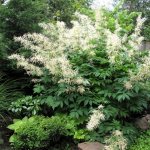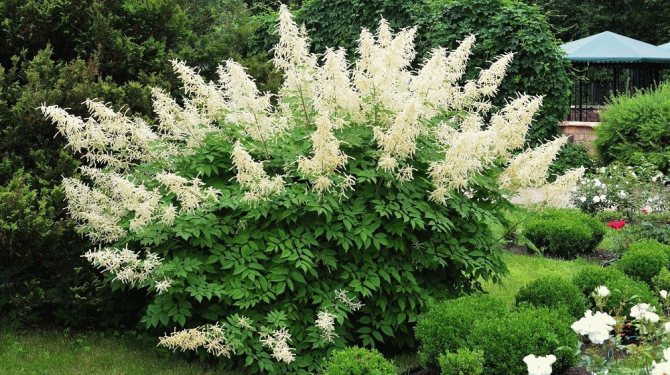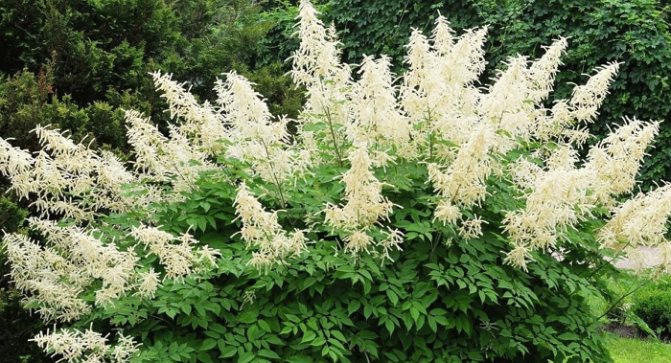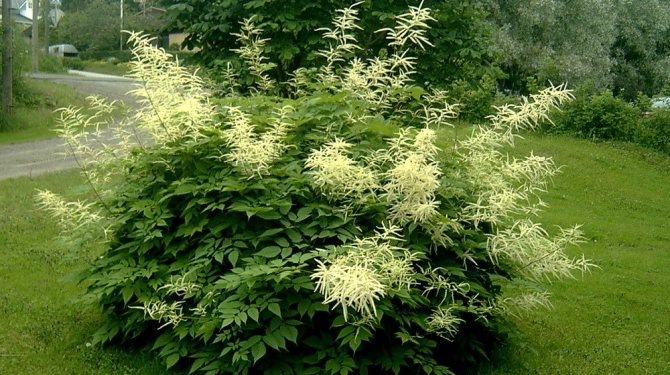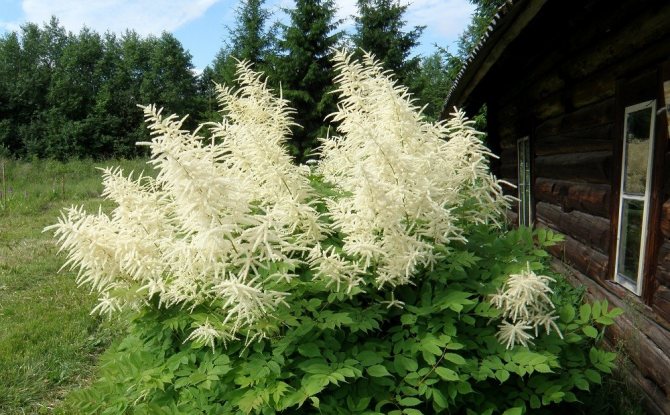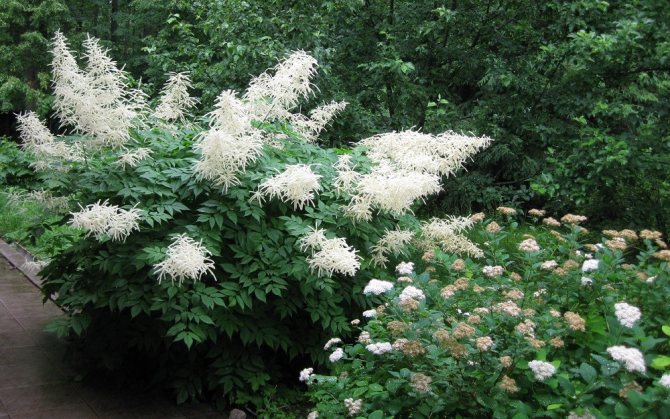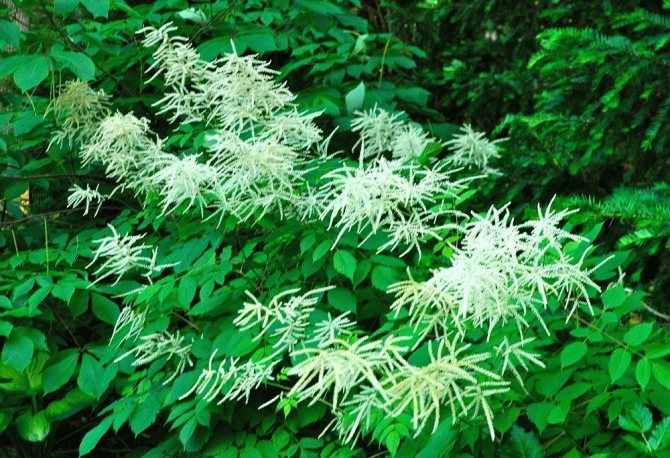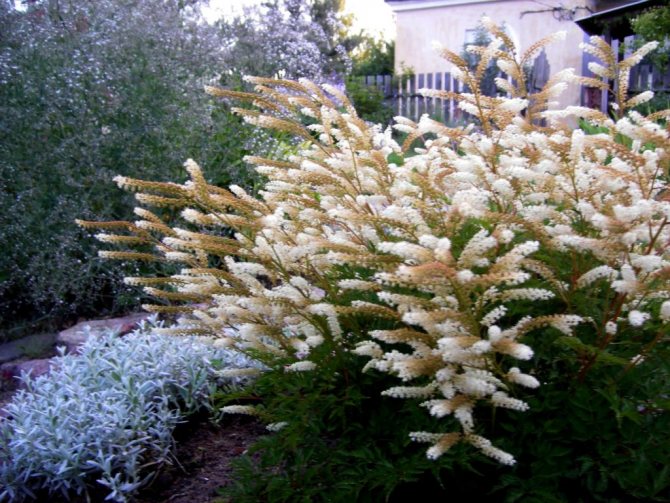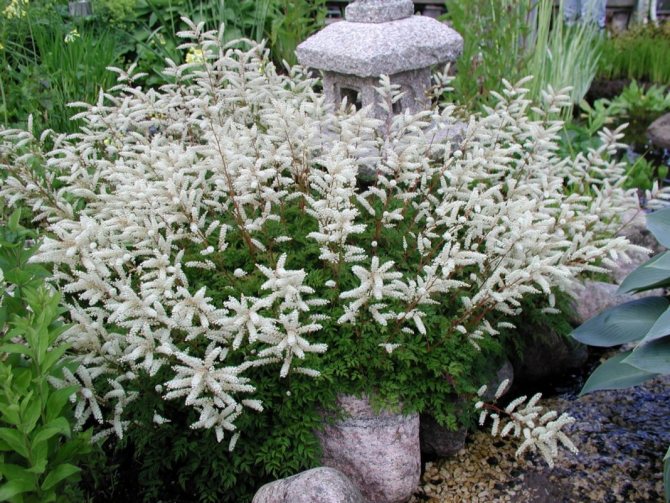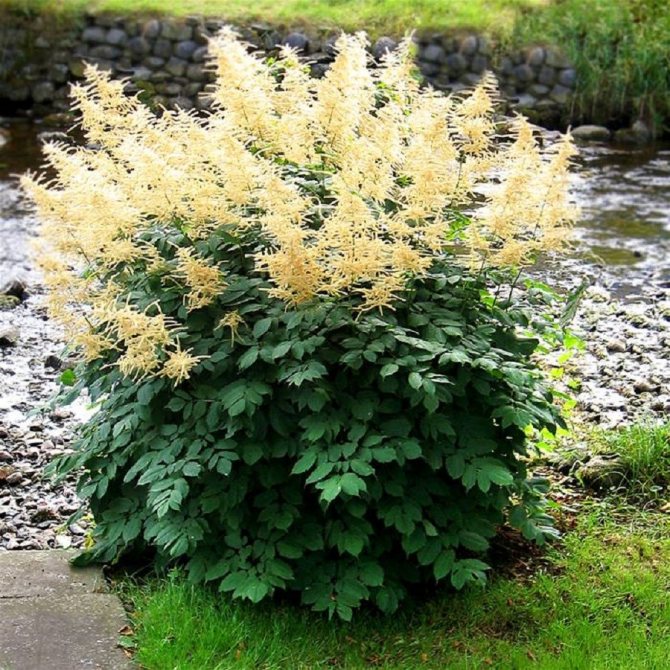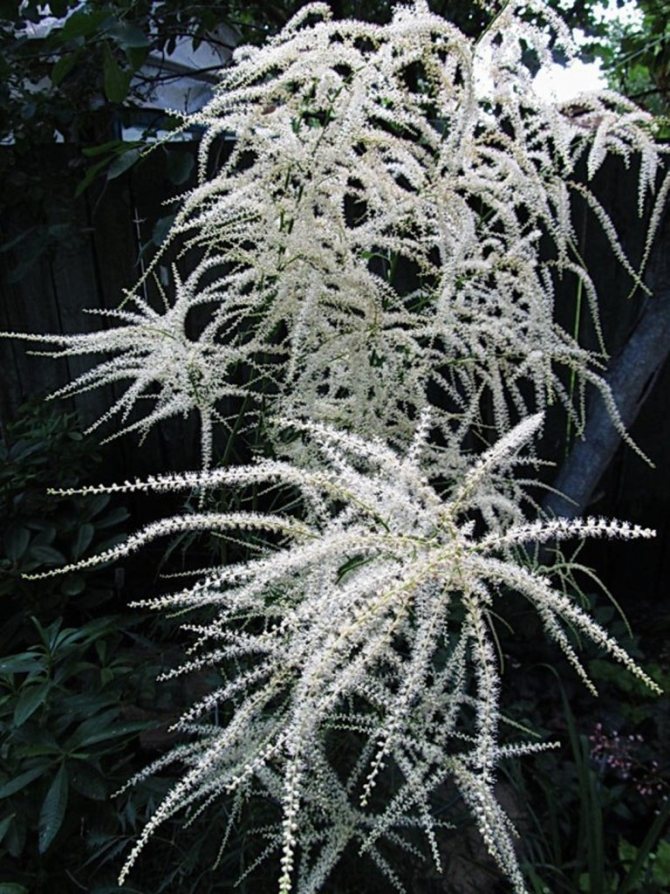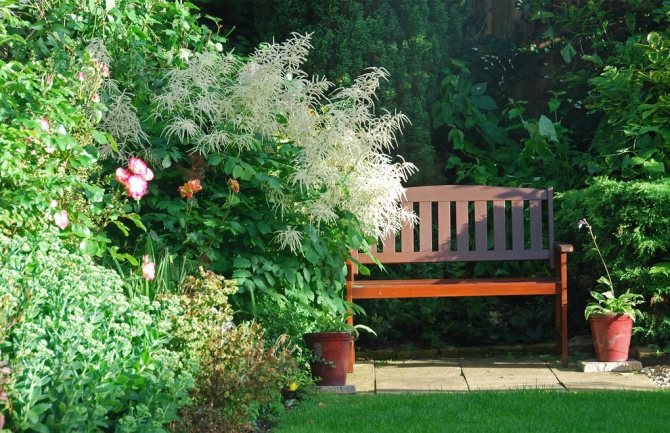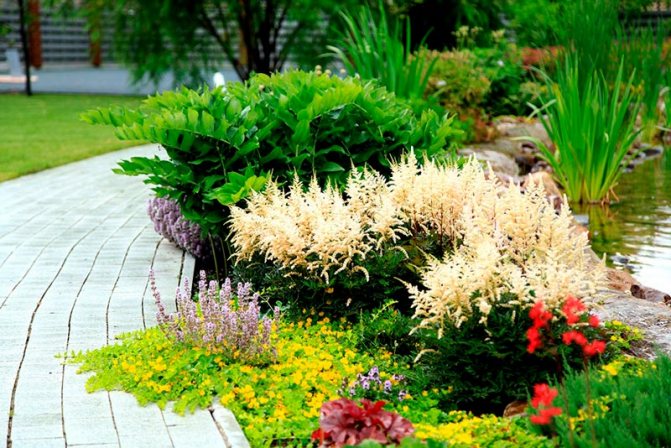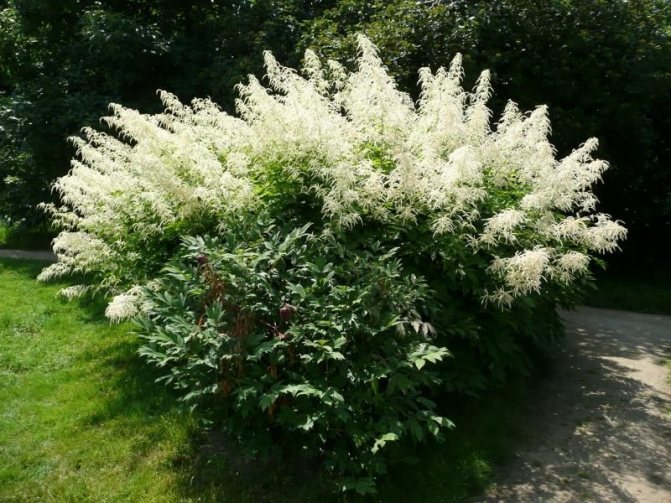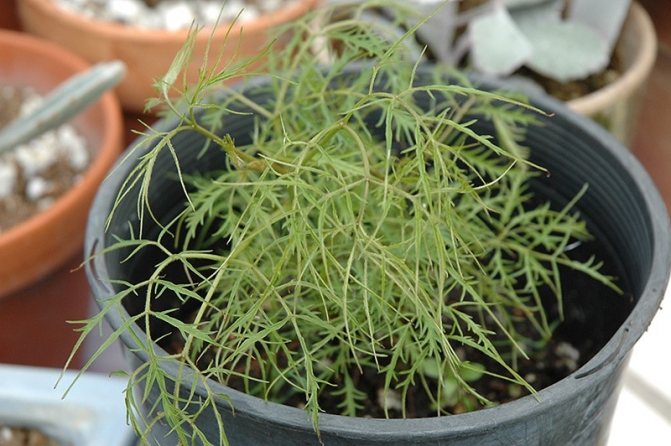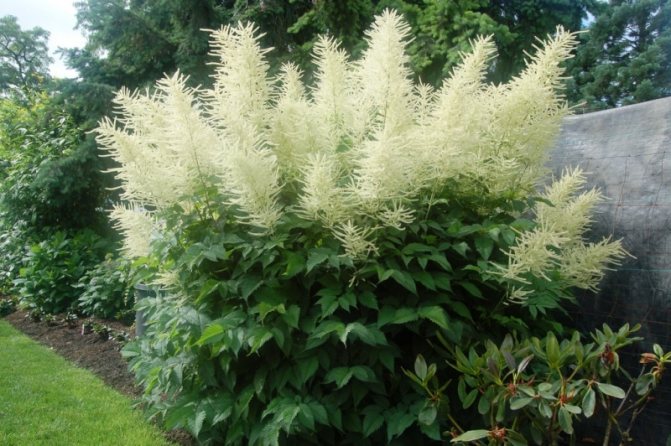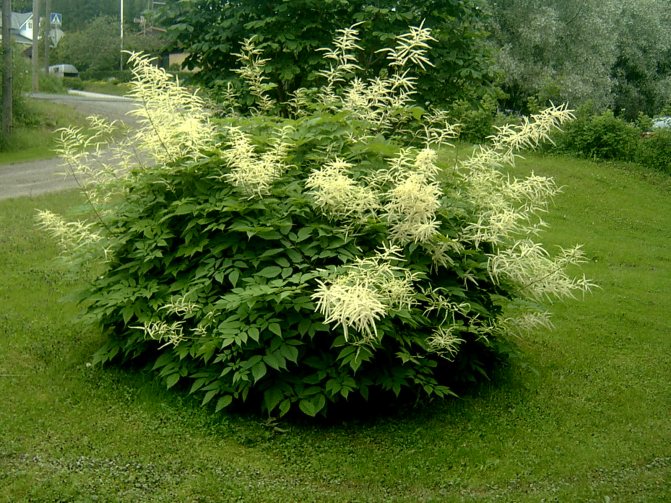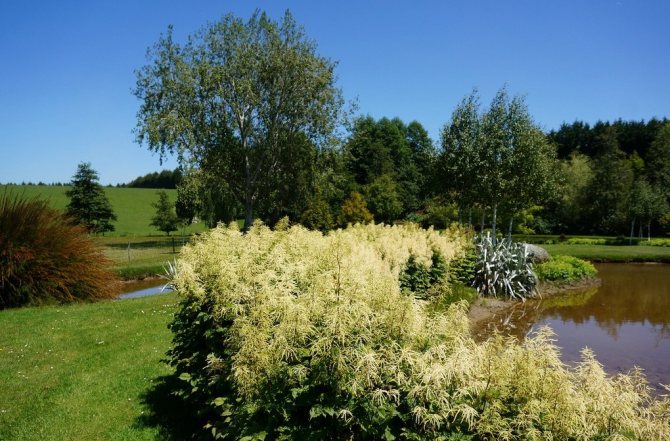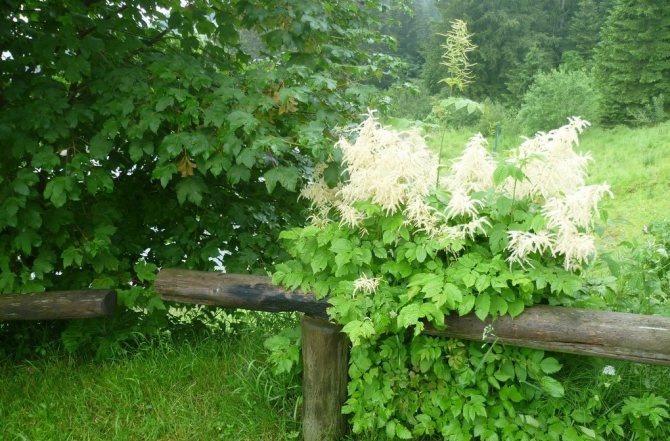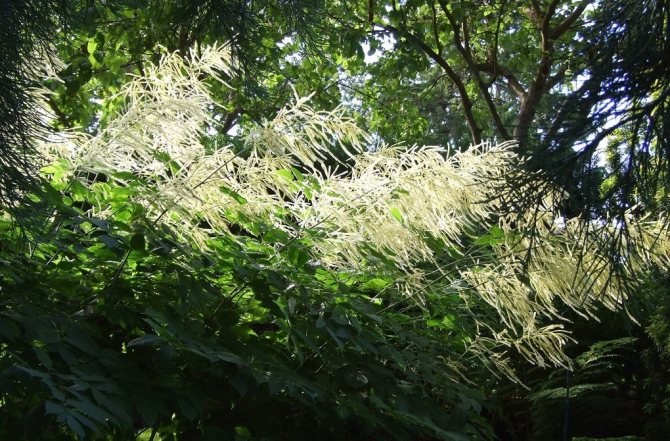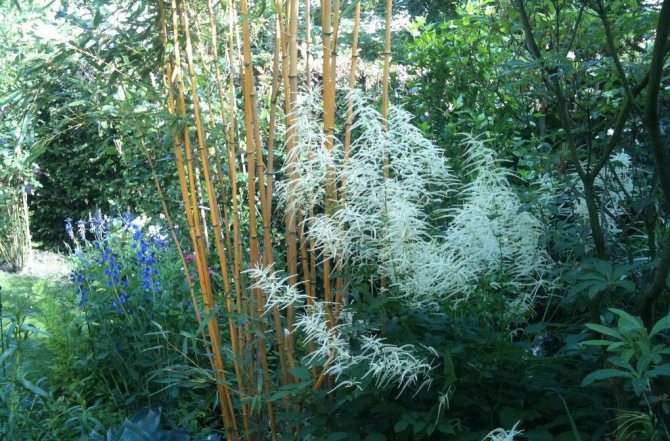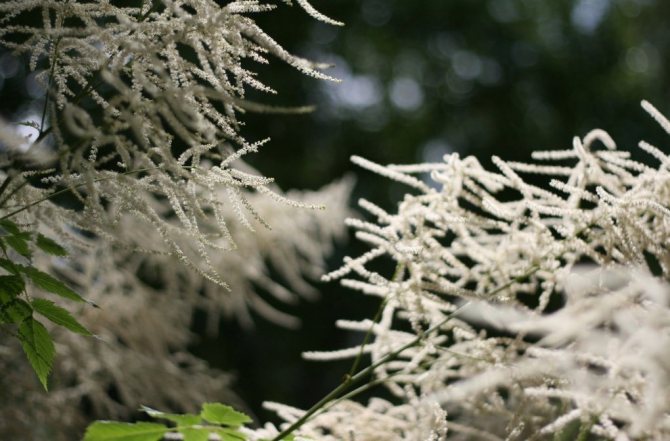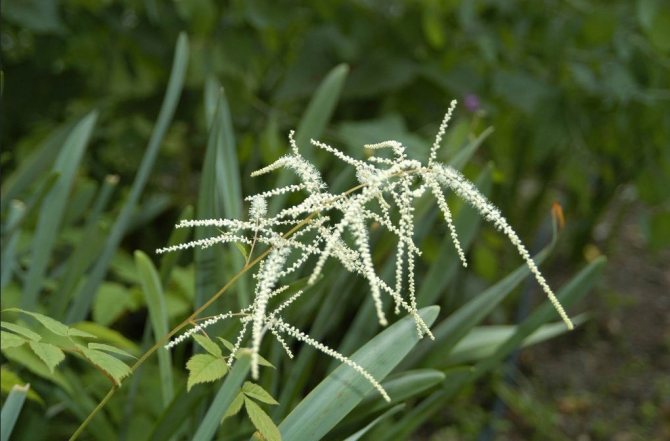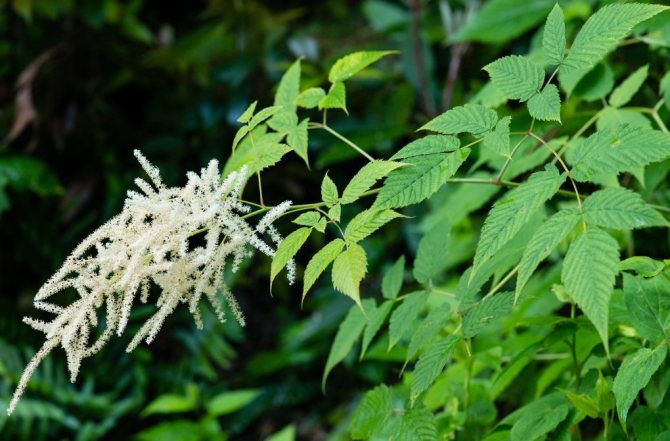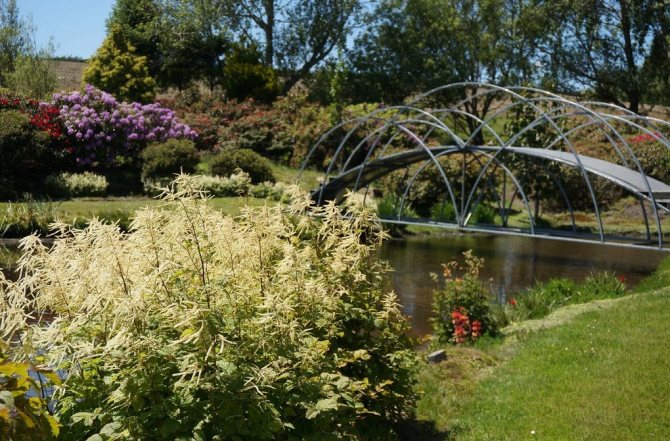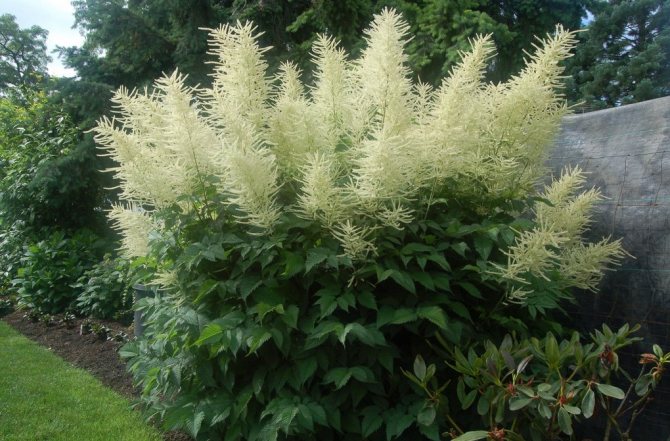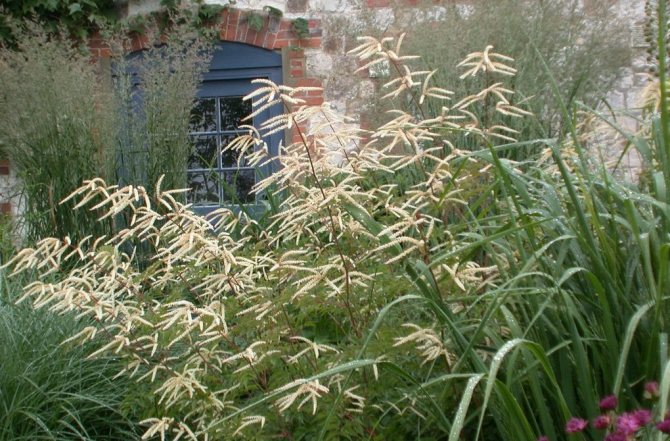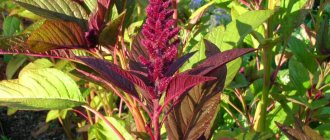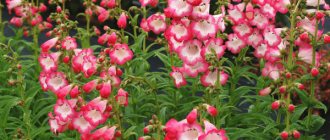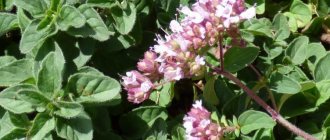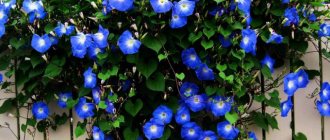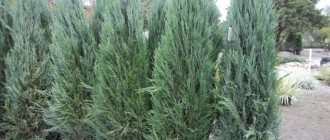Volzhanka or aruncus is a voluminous and very spectacular herbaceous shrub for the shady area of the personal plot. In blooming form, this plant with a dissonant translation (Greek - goat's beard) is able to give an absolutely incomparable feeling of a warm summer, a bright holiday, lightness and freedom from city worries. It is enough to look at the photo of the Volzhanka to imagine the volume, splendor and decorativeness of this frost-resistant and shade-tolerant perennial. Planting a flower in open ground, as well as subsequent care for it, is simple and within the power of a gardener with any experience.
Volzhanka: varieties and varieties
A lush, spreading bush of dense greenery with white arrows of flowers is a perennial Volzhanka (lat.Aruncus) or aruncus. This flower stands out in any flower garden or garden for its size and unusual shape of leaves and inflorescences. Volzhanka exudes a delicate honey aroma.
The sprawling Volzhanka bush is able to decorate any suburban area
Recommended for outdoor cultivation dioecious volzhanka
(lat. A. dioicus) or, as it is also called, forest. The shrub is striking in its size: it can reach up to 1.8-2 m in height, and up to 1.5 m in diameter. The flowering of Volzhanka lasts about 2 months - from June to July. The leaves are openwork, ragged, inflorescences are collected in white panicles more than 50 cm long.
Variety "Kneiffii"
- Volzhanka variety "Kneiffii" looks especially beautiful and delicate in the photo. A medium-sized bush (up to 55-65 cm high) has an amazing leaf shape - they seem to be cut into narrow sectors.
- The variety Chinese Volzhanka (Latin A. sinensis) is also widespread. It is distinguished by inflorescences of a soft cream tone, and the leaves of the perennial are painted in reddish-bronze tones.
Chinese Volzhanka
The variety grows up to 100 cm volzhanka asian
(lat. A. asiaticus), her leaf dissection is less than that of dioecious volzhanka, the plant looks a little monumental because of the inflorescences collected in thickened panicles.
Asian Volzhanka
Among undersized varieties of Volzhanka
should be highlighted:
- Alpine Volzhanka (lat. f. Alpine), the bush grows no more than 25-30 cm;
- Volzhanka kokoryshilistnuyu (lat. A. aethusifolius), its leaves are slightly twisted, bright green, inflorescences are soft cream.
Volzhanka kokoryshelistnaya
Breeders for growing in the open field have developed new varieties and varieties of Volzhanka, differing in the color and shape of foliage, flowers and peduncles. So the variety "Johannisfest" pleases with creamy inflorescences and openwork (torn) foliage, "Waldemar Meyer" is a tall shrub with bright white flowers, "Misty Lace" is distinguished by fern-like emerald green leaves, reddish peduncles and soft cream inflorescences.
Use in landscape design
At every home or summer cottage there are uncomfortable places where garden plants refuse to grow. This can be the north side of the garden, constantly shaded glades under the trees, waterlogged areas with groundwater close to the surface.
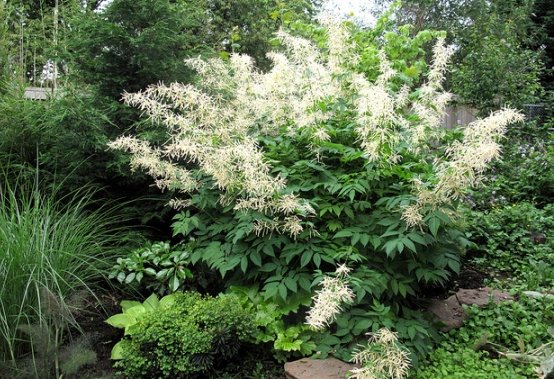
To decorate such places, a real find of a landscape designer can be dioecious volzhanka - a herb for open ground.In addition, it is used to mask a mesh or fence between adjacent areas, to decorate the banks of ponds and reservoirs, which are becoming more popular in garden areas.
Volzhanka looks great on flower beds in combination with other flowers and opens up excellent opportunities for decorating a personal plot. Compositions of volzhanka and other ornamental plants will create a harmonious atmosphere, create a place for relaxation in the country or in a private house.
Planting Volzhanka
When planting Volzhanka, you should choose shaded areas with wet soil. Therefore, the perennial is excellent for planting on the banks of reservoirs, in the garden under the spreading crown of fruit trees. It tolerates shade and high humidity very well. Volzhanka's soil requirements are minimal - she loves light, well-drained soils.
For planting Volzhanka, they dig a hole measuring 50 x 50 x 50 cm, fill it with a mixture of compost or humus (it is recommended to add at least a bucket) and the top fertile soil layer. New bushes should be planted at least 80-100 cm apart to enable them to grow normally.
Young volzhanka bush
Attention: Volzhanka can grow in one place for up to 2 decades.
Volzhanka in the landscape
Due to the monumental size of most species and their high decorativeness, the plant is quite self-sufficient and can be planted as a tapeworm on lawns, near the shores of artificial and natural reservoirs, in the local area, in the shady corners of the garden, hiding their unsightlyness. Due to its compact size, dwarf species will perfectly decorate garden paths, curbs, barbecue areas. Volzhanka looks great in group plantings along with conifers and other deciduous shrubs. If you plant it in the background of a flower bed, then its bright greenery after flowering will perfectly set off flowering annuals.
Aruncus panicles do not live long in cutting, but they are great for drying and composing dry compositions. In this case, you should be prepared for the fact that the dried plant, upon contact with it, will heavily litter.
The versatile perennial plant Volzhanka is very popular in landscape design. The decorative appearance of the garden planting is preserved even after its flowering, decorating even the most inconspicuous parts of the landscape. The culture is completely unpretentious: it grows successfully both in the sun and in the shade. Resistant to excess or lack of moisture. This is a real find for landscape design! The plant reaches a height of 150 to 200 cm. It is decorated with small flowers with numerous stamens, their color is pastel colors. The bush emits a delicate, delicate aroma. The color of species that are grown in the open field is close to yellow.
Volzhanka, as a plant that does not require maintenance, is often used in landscape design to create picturesque thickets. They perfectly mask unsightly fences, structures, traces of communications, etc. If the gardener has planned to form rocker and ceremonial plantings, then it is better not to find a Volzhanka plant. The soft delicate shade of the bush will give the landscape a touch of romanticism, smooth out the strict architectural forms.
When planting a plant near the water, you can admire the incredibly beautiful reflection of a flowering shrub in the water. A pleasant delicate aroma emanating from Volzhanka will turn the garden into a piece of paradise. Due to its unpretentiousness, the garden planting can be planted at the very edge of the water or on the coastal zone. The culture perfectly coexists with other plants, which allows you to create an original mixborder near the elements of water.
Volzhanka is a very good honey plant. Due to this, it attracts numerous pollinators to the site.Taking advantage of this property, gardeners plant fruit trees nearby and enjoy a good harvest at the end of summer.
Plant care
Volzhanka needs minimal maintenance. It should be regularly watered. Even mature plants need to be watered during dry periods.
After flowering, it is necessary to remove the peduncles, and in the fall, cut off the shoots on the bush, leaving only small stumps up to 5-7 cm high.
Even for minimal care, Volzhanka will thank you with abundant flowering.
The perennial is frost-resistant, but on the eve of a harsh winter, the trimmed bush should be covered with foliage, spruce or humus.
general description
Volzhanka is a large herbaceous perennial from the Rosaceae family. The plant has a great external resemblance to astilba. In just one season, Volzhanka is able to grow a large volume of green mass, due to which it is perceived not as a herb, but as a monumental deciduous shrub. The culture is widespread throughout the temperate zone of the Northern Hemisphere, therefore it easily winters in Russian gardens and in personal plots.
Aruncus has a highly branched surface-type root system. Over the years, its lignified roots stretch far beyond the planting. Erect strong skeletal branches remain overwintering, dropping foliage. The growth is given unevenly, in the first years it is insignificant, but later the plant can reach one and a half meters. Its spreading crown in width occupies a little less.
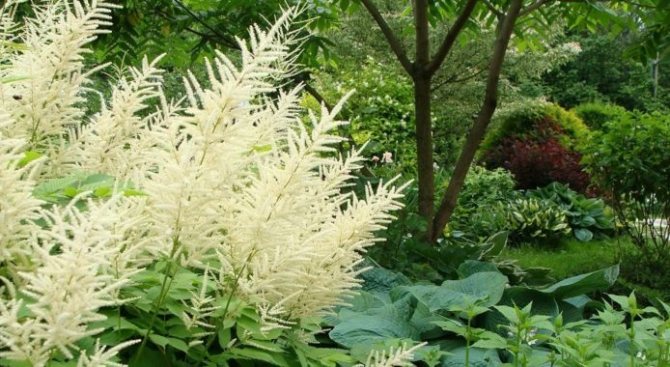

Long-stemmed foliage has a bright green color and carved edges. Peduncles are an extension of the stems and can reach more than half a meter in length. Flowers of pure white or light cream color are small (up to 3 mm), collected in dense spike-shaped inflorescences. Due to the green perianths protruding forward, they have a slight greenish tint. On one specimen, their bisexual varieties develop. Male ones are distinguished by special splendor and density, female ones are determined by an openwork edge and are seated more rarely.
Flowering occurs in the first half of summer. Blooming aruncus infuses the garden with a tart and strong honey scent that attracts large numbers of bees and other pollinating insects. Leaflet fruits ripen much later, in September, the seeds are very small, dusty.
The annual growth of roots in tall varieties is 5-7 cm per year.
Volzhanka reproduction
A perennial shrub can be propagated in 3 ways:
- dividing the bush;
- green cuttings;
- seeds.
The most effective way to breed Volzhanka is dividing a bush
with a subsequent transplant. At the same time, it should be remembered that the rhizome of the old plant becomes stiff and it is rather difficult to separate it. Therefore, gardeners recommend using this method for dividing shrubs no older than 7 years.
The division is carried out in spring (April-May) before flowering or in autumn (early-mid September) after its end. The transplanted plant blooms, as a rule, the next year.
The plant can be propagated by cuttings or dividing the bush.
Propagate Volzhanka by cuttings
it is possible all summer long, separating young green shoots and burying them in moist shaded soil.
Growing Volzhanka from seed
- a more laborious process, even with proper care, the shrubs will bloom only for 3-4 years. Seeds should be harvested in September, planted in special containers or in a designated place and left for the winter for stratification. In the spring, perennial seedlings dive, leaving 1 plant for every 15-20 cm. The grown bushes are transplanted to a permanent place of growth in open ground only in the second year.
Aruncus - planting subtleties
Before you start planting a plant, you need to carry out preparatory procedures. Take care of the soil first.Volzhanka mini is a perennial plant that can grow in one place for about 20 years. Important points:
- The soil must be nutritious enough.
- Fertilizers are applied directly to the hole before planting. It is recommended to use about 2 kilograms of peat, and humus (you can replace 1 tbsp. L. Nitrophoska).
- Before immersing the bush in the hole, it is well poured with water.
- After immersion in the hole, the roots are well straightened, sprinkled with soil, trampled down and watered.
If seedlings germinated from seeds are planted, then a year must pass before they are planted in open ground. This period should fall in the fall.
A meter interval should be observed between planting.
So that the seedlings are good for the role, and go into growth, fertilization should be applied at least every 2-3 weeks.
When the planting takes place by a vegetative method, then the optimal season is spring (the first month, as soon as the snow melts). The wells are prepared deep enough (40 cm by 40 cm by 40 cm). The growing season lasts until mid-July.
Volzhanka of any variety does not like dividing the bush, so she needs to be helped to endure this difficult period: plant in a shaded place, water abundantly. When planting the plant in this way, the distance between the bushes should be about 70 centimeters. Already in the second year, it will be possible to observe abundant flowering (in the case of seed reproduction, this period is much longer).
High varieties of Volzhanka are planted in such a way that she has the opportunity to grow. For a shrub about a meter high, you need 1 square meter for planting. m. For dwarf varieties, no more space is required. If you want to plant aruncus in a flower bed, then the variety must be miniature. A densely planted Volzhanka will develop poorly and bloom poorly.
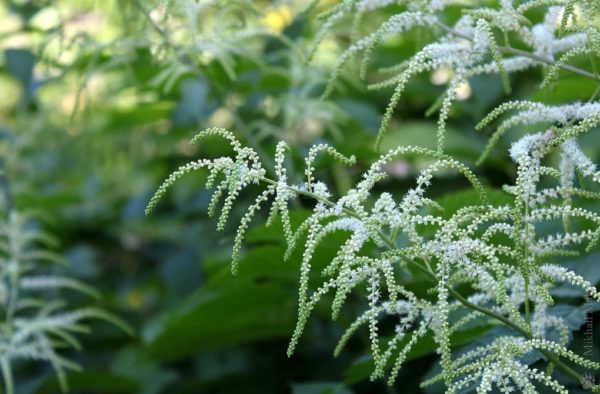

Volzhanka in combination with other plants
Tall Volzhanka looks great in combination with low-growing plants, creating a bright white-green background for them.
Attention: when planting Volzhanka, it should be remembered that the bush, growing, can shade other plants.
Perfectly combined with Volzhanka:
- low astilbe;
- high delphiniums;
- spireas;
- large hosts;
Volzhanka on a flower bed
- barberry;
- shieldworm;
- sprawling fern;
- cotoneaster.
In landscape design, aruncus is used as a plant for decoration and shelter from prying eyes of unsightly corners of the site, decorating an old garden, reservoirs. Growing up, the bush reliably hides the walls of houses, fences, and outbuildings behind it. In a single planting, it is planted in the middle of the lawn, in a group of plants - in the background.
Volzhanka in landscape design
Volzhanka is easy to care for, undemanding to soil, watering, this is a real green miracle.
Possible diseases
As mentioned above, Volzhanka is a fairly strong plant with good immunity. And the better it is cared for, the more resilient it will be. At the same time, everyone can face the following problems:
- Aphid.
- Mite.
- Small green caterpillars.
To avoid pests, spraying should be carried out. Caterpillars appear actively at the beginning of summer, so the plant needs careful examination. If damaged leaves are found, they are immediately treated with the necessary preparations.
Pests can be dealt with using folk methods, for example, spraying with soapy water. But it is better to contact a flower shop, where they will advise the necessary remedy. If you do not start pest control in time, the plant will simply die.
A huge plus of Volzhanka is that it is not susceptible to diseases associated with putrefactive processes. Therefore, the plant is not afraid of dampness. Aruncus is resistant to various weather conditions, such as frost.If, nevertheless, part of the stem and root is damaged, it will quickly recover itself.
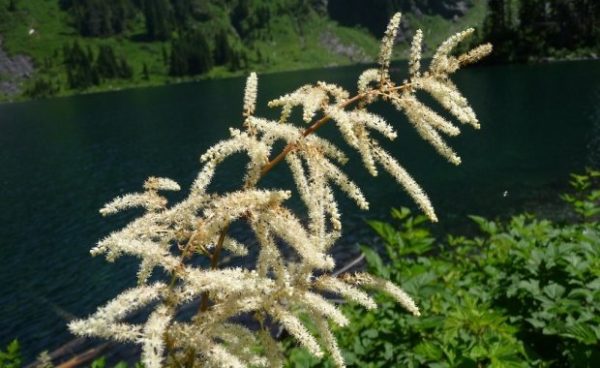

Varieties of Volzhanka: photo
The genus Volzhanka is represented by perennial plants with beautiful foliage and lush paniculate inflorescences. This genus belongs to the Rosaceae family. Volzhanka is increasingly used in gardening and landscape design and is appreciated not only for its high decorative effect, but also for other qualities - frost resistance, shade tolerance and the ability to grow both in waterlogged and dry soil. When the plant is in bloom, there is a pleasant honey scent throughout the garden. What is required for this? Let's talk about what conditions Volzhanka likes in the open field. This topic of this publication is for readers interested in this plant "Popularly about health".
Volzhanka - a short description
If you like to walk near water bodies, you have probably seen beautiful Volzhanka bushes on the coast more than once. It is difficult to pass by her, remaining indifferent, because the inflorescences attract the eye from afar.
So, what is Volzhanka? This is a bush reaching a height of one and a half meters with openwork green leaves. Its inflorescences are lush and large, reminiscent of panicles. On some bushes, they grow up to half a meter! Flowers in inflorescences are very small, but densely arranged, white or beige. When flowering ends, Volzhanka does not lose its decorative effect, therefore it is readily used in landscape design both as a single plant and as a group plant.
Often this perennial acts as a backdrop for undersized flowering crops. This shrub has so many advantages that it undoubtedly arouses the interest of gardeners in it. But this is not the end of his positive qualities - caring for a Volzhanka is so simple that even the most inexperienced amateur gardener can cope with this task.
In the photo Volzhanka
Outdoor planting in different ways
Planting Volzhanka seeds is not very widespread, but still takes place. Seeds are sown in autumn, as they need to undergo stratification for germination. In the spring, young plants dive, keeping a distance of about 20 cm between them. For the winter, the bushes are covered very carefully so that the young culture does not die. And only next spring the Volzhanka bushes are seated in a permanent place, leaving a distance of a little more than a meter between them. Plants grown from seeds will delight you with flowering only after 4 years. Not all gardeners are ready to wait so long, so most often they root cuttings or cuttings of Volzhanka into the ground. Bushes are usually divided in early spring, when the plant is just waking up. It is not recommended to divide on old bushes that are more than seven years old. Shrub roots at this age are difficult to separate. Divided bushes will delight you with flowering next year. Cutting is an easy way to propagate Volzhanka. Shoots are rooted directly in open wet ground.
Since this plant can grow in the shade, then use the shady corners of your garden for planting it, leave sunny areas for other crops. Prepare holes 50 cm deep. The distance between new bushes is at least one meter. Combine the soil with compost and humus, fill the holes with it by a third. Then place a seedling in the hole and fill the remaining space with potting soil. Water. In the first year after planting, the plant does not need feeding if you have introduced organic matter. Unless it makes sense to add mineral supplements containing potassium and phosphorus a couple of times a season. Having identified a perennial for a permanent place, it is worth taking care of its further development.
Plant care on the site
Caring for Volzhanka is a pleasure. The plant is not demanding on the soil, calmly tolerates short-term drought, is not afraid of waterlogging and stagnation of water, since it lives in nature near natural reservoirs. Pests rarely affect luxurious bushes.Unless some species of caterpillars can feast on juicy foliage.
What efforts are required from the gardener so that the bushes develop well and bloom profusely? Young seedlings require weeding. Watering is carried out abundantly during periods of drought and extreme heat (3 buckets of water). When flowering ends, all dry inflorescences should be cut off so that they do not spoil the appearance of the plant. In the fall, all shoots are also subject to removal. They are cut so that only small stumps about 7 cm long remain.
Although the perennial is a frost-resistant crop, it is still worth organizing a shelter for the winter in the form of dry foliage in case there is little snow. In the spring, before the start of sap flow, gardeners recommend applying a portion of organic fertilizers under each bush, then Volzhanka in the middle of summer will bloom profusely and for a long time. Flowering usually lasts about 4 weeks, but there is a dependence on weather conditions. In extreme heat, the duration of flowering is slightly reduced.
Volzhanka is a shrub loved by many gardeners. Undersized crops, for example, astilbe, look great against its background. Bushes are also good as single plants when placed in the center of the lawn or in the background of the plot. A delicate honey aroma is a perfect complement to the beauty and grace of the plant. If you value crops that do not require much attention when grown outdoors, then Volzhanka is one of them.
This is a large plant about 2 m high in bloom and up to 1.5 m in diameter. The leaves are dark green, large, complex, collected from smaller leaves. Blooms from mid-June for about one and a half months. Inflorescences are fluffy, large, 40-50 cm long, cream-colored with a tart honey smell that attracts many insects.
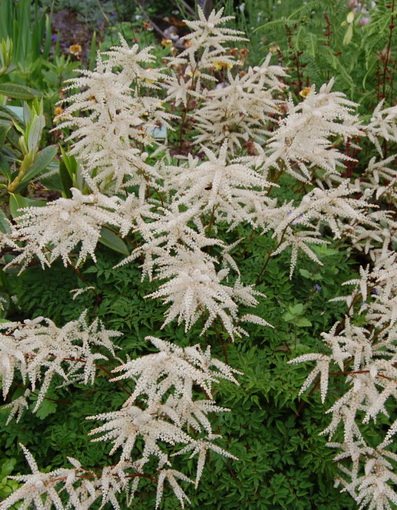

Those for whom this plant is too large can be offered a lower form of Kneffi (f. Kneifii) 50-60 cm high. The leaves of this plant are more graceful, thinly dissected, bright green. The inflorescences are also smaller in length and not as fluffy. In general, this form looks more graceful.
Besides Volzhanka dioecious
, in the same conditions, the Chinese (A. chinensis) grows well. This is also a large plant, but blooms later - in July - August. There is an interesting variety "Zweiweltenkind", the leaves of which are reddish in spring. Inflorescences are white, large.
For curbs, you can use Volzhanka
cocoa (A. aethusifolius) It is beautiful with its dense juicy green bushes 25-30 cm high and up to 50 cm in diameter, acquiring red tones in autumn.
There is a grade of this Volzhanki
Noble Spirit, which reproduces well by seeds. It blooms with pure white panicles in May-June. After flowering, the inflorescences are not cut off, since when the seeds ripen, they turn red and additionally decorate the plants.
Recently, new varieties have appeared Volzhanki
.
Among the best: "Johannisfest"
(60 cm) with delicate foliage and cream flowers;
"Waldemar Meyer"
(110 cm) with white flowers in narrow inflorescences.
"Misty Lace"
(75 cm) with bright green "fern" leaves, red stems and petioles, cream flowers is not only beautiful - it tolerates heat and drought well enough.
LOCATION:
Everything Volzhanki
grow well and bloom in shade and partial shade. Their foliage can burn in the sun. But if you plant it in moist soil near a pond, it will grow well in the sun.
The soil
any sufficiently fertile and moist is suitable for her. In dry soil, Volzhanka feels depressed and does not show full beauty.
CARE:
Volzhanki
grow in one place for up to 10 years, therefore, they simply need spring feeding with organic fertilizer and autumn mulching of the soil under the bushes with leaves, a layer of 10-15 cm, (to retain moisture and additional feeding).
Peduncles can be trimmed after flowering, and bushes are trimmed in the fall 5 cm from the ground.
With prolonged drought Volzhanka
you need to water - at least 2 buckets of water on an adult bush.
They winter well in the middle lane without shelter.
Aruncus is popularly known as Volzhanka, is a perennial garden plant that forms beautiful neat bushes that will decorate your summer cottage. The big advantage of the plant is that Volzhanka is not demanding to care for, it can develop for a long time without supervision, it has numerous species and varieties. The article discusses the most popular types of Volzhanka and the features of its cultivation in gardens.
Rhizome division
In the case of vegetative propagation, you can get a flowering plant in a shorter time. It is recommended to make division in early spring after the snow melts, before signs of sap flow appear in the ground part. To do this, it is not necessary to dig up the entire mother bush, it is enough to dig out part of the overgrown rhizome. You will have to chop it with an ax or a sharp knife, since the root becomes stiff and very strong. Each division must have at least one regeneration bud and part of the filamentous roots, which must be carefully preserved, since they will nourish the plants during the rooting period. It is advisable to sprinkle the cut site with ash, chalk or coal. Delenki are immediately buried so that they do not dry out. Already in the first year after planting, a new plant can bloom.
Aruncus dioecious, or ordinary (Aruncus dioicus)
The homeland of this Volzhanka is considered to be the regions of Northern Europe and the Caucasus. The plant looks like astilba,
however, they belong to different families, have some differences in terms of color and size. Volzhanka comes from the Rosaceae family, and astilbe comes from the Kamnelomkovy family. The color options for flowers in Astilba are much richer and do not depend on the "sex" of the plant. Flowers can be purple, beige, white, pink or red. While the female Volzhanka inflorescences can only be white, and the male ones - beige. Volzhanka common is much larger in size than astilbe, and its flowers are denser. Aruncus dioecious in height can reach 2 m. The stems of the plant are long, straight, form bushes up to one meter in diameter. The leaves are a bit like a fern, they have dense petioles. It blooms with small flowers (male inflorescences are beige and dense, female inflorescences are white and more rare). Volzhanka inflorescences resemble a herringbone in shape, in length they can reach up to 50 cm.
Flowering time falls in June and July.
The plant has a very pleasant tart smell, so it is very fond of pollinating insects. In September, the Volzhanka throws out seeds. If sown before December, Volzhanka should not bloom until three years later.
Did you know?
Volzhanka is growing very quickly. If you want to form beautiful bushes out of it, cut the stems regularly after flowering. The plant perfectly tolerates pruning of stems and inflorescences, it can take on a variety of geometric shapes.
Volzhanka dioecious differs from other species in its large size. The most popular varieties of common Volzhanka include:
- Kneifi - has beautiful, highly branched openwork leaves, reaches a height of up to 80 cm, hygrophilous;
- Volzhanka forest Dzineya fow - reaches a height of 2 m, inflorescences are white with a slightly pinkish tinge;
- Misty Lace - about 70 cm high, rich green leaves, forms neat small bushes, flowers have a delicate creamy shade.
Types of Volzhanka dioecious
The most common variety of this plant is the common aruncus. Its distinctive feature is the rather large size of the bush. Such a variety of it as Kneffi on the site of a country cottage can grow up to 85 cm in height.And the forest volzhanka reaches a height of up to 2 m.
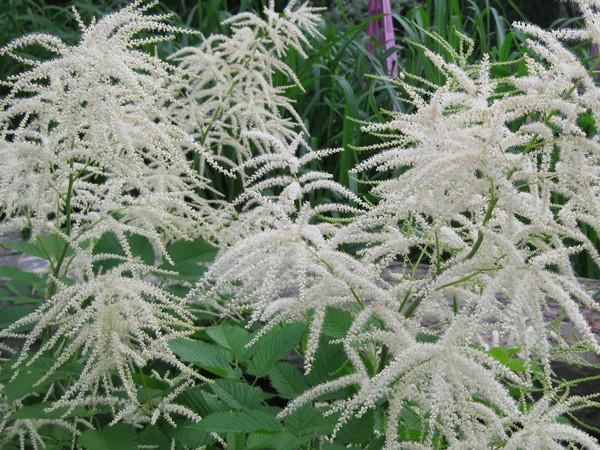

The male flowers of the Volzhanka dioecious plant are beige in color. They are denser and thicker. Female flowers are white, openwork, loose and fluffy. The gentle fluttering of the fluffy buds in the breeze creates the feeling that the shrub is spreading a soft, diffused glow. This brings to life the darkest and darkest corner of the garden.
Usually by the fall, the inflorescences are cut off. If left, you can see a color change from beige to light brown, which fits well with the concept of a "wild garden".
American Aruncus (Aruncus americanus)
The homeland of this species are areas of North America. The plant reaches a height of one meter. Blooms from late May to mid June. This species is distinguished by a long rhizome, which lengthens by 7 cm every year. American Volzhanka forms less branched bushes than dioecious. The leaves of this species are three times pinnate, have a light green tint. Inflorescences are small, white, shaped like spikelets. Volzhanka does not bloom as abundantly as the usual one, and therefore does not look as voluminous. Due to its low growth and compact bushes, this type of plant is very popular. Shrubs are often used for landscaping.
Volzhanka reproduces with the help of seeds, petioles or division of roots. For the formation of landscape design, it is better to choose reproduction by dividing the roots.
Important!
For vegetative propagation, be sure to leave a few roots and at least one bud on each part of the bush. After dividing, individual parts of the bush must be immediately planted in the ground, otherwise the plant will die.
Growing and care
Growing a Volzhanka plant does not require much effort. The maximum growth of aruncus occurs from May to July. At this time, flowering reaches its greatest scale. Before and during this process, it is advisable to fertilize the soil every 15-20 days. You need to alternate between organic and mineral baits. Nitrogen fertilizers are applied after planting in the ground, and phosphorus-potassium fertilizers - after the end of flowering. At the same time, young plants that were planted in pits with soil already enriched with humus do not need to carry out such procedures at all.
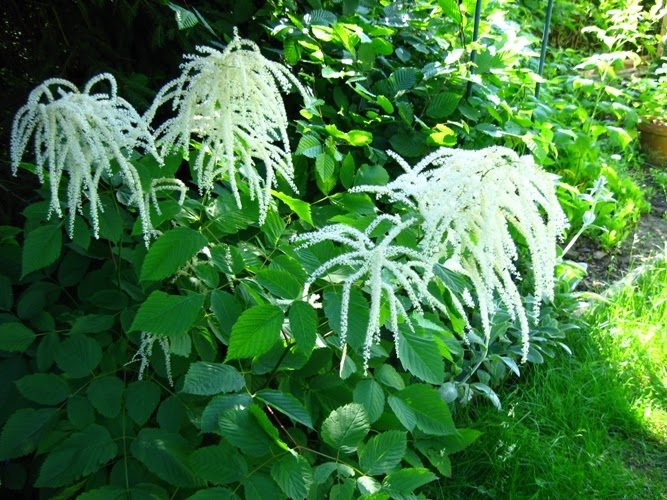

In dry periods, the plant must be watered, since growth and flowering slow down with a lack of moisture. At the end of flowering, the panicles are usually cut off. This is necessary so that the leaves do not become small.
In the fall, before freezing, the bushes are cut off, leaving hemp of a few centimeters, mulch the soil under them with sawdust or peat and cover with fallen leaves.
Asian Aruncus (Aruncus asiaticus)
This species is native to Siberia, refers to tall. It reaches a height of two meters. Volzhanka leaves are double-pinnate, rich green. It differs from other species by a short root system, coarse and less branched foliage, and dense flowering. Inflorescences are small, reaching up to 40 cm in length. Blooms in June.
The Asian Volzhanka is also surprisingly hardy.
In the wild, it can be found in the forest zones of Siberia, Eastern China. Prefers partial shade and fertile soil, hygrophilous. Often used to decorate fences, walls.
What is the plant afraid of?
It is not winter frosts that are terrible, but spring frosts. If young leaves or inflorescences hatch, they may freeze. There is no need to despair. Special care is not needed, the bush will recover from dormant buds.
The enemy of aruncus is the bright sun. If the plant is planted in an open area, the foliage turns pale, discolored, growth freezes, the inflorescences refuse to bloom.
The plant is resistant to disease. The sawfly poses a danger to the leaves. Its green caterpillars gnaw at the leaves from the back side, first leaving streaks, and then forming holes. Young leaves are eaten completely.
Advice
Digging, loosening, weeding in summer and autumn will help to get rid of the sawfly. If the lesion is difficult to stop, spraying will have to be applied.
Aphids and mites also attack willingly, but do not bring such damage to the plant.
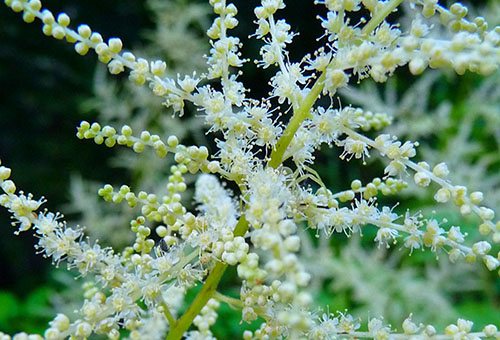

Aruncus Kamchatka (Aruncus kamtschaticus)
In the wild, this type of plant can be found in the Far East, Alaska, Korea, Sakhalin, Kamchatka, Okhotia, the Arctic, Japan. It can reach a height of 30 to 150 cm. It has a thick, powerful root system. Leaves are double-pinnate, oval in shape. Inflorescences are abundant, slightly branched, up to 20 cm long. Aruncus of this species blooms in July-August. Seed ripening occurs in September.
Prefers partial shade. Often used to decorate park areas.
One of the most popular varieties of this species is Alpine. Differs in low growth (30 cm), small neat bushes.
Did you know?
On Sakhalin, very tasty dishes are prepared from young spring stems of Asiatic Volzhanka, after soaking and boiling the shoots.
Variety "Horatio"
This variety differs significantly from the Volzhanka plant, primarily in its size. The height of its stems does not exceed 65 cm. They are colored red.
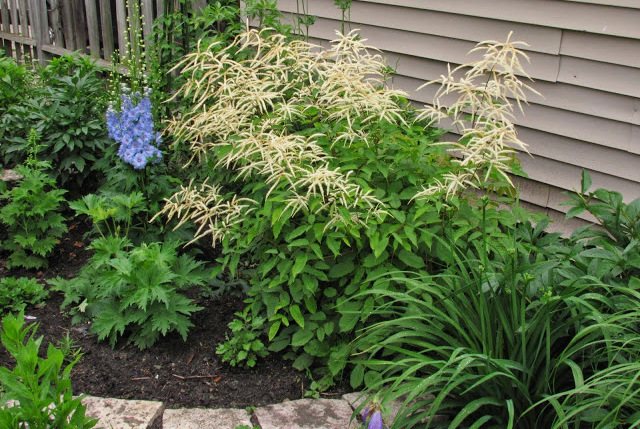

Used to decorate flower beds in combination with other plants. It attracts designers with its unpretentiousness. "Horatio" can be in the ground for a very long time without transplanting and with proper care it blooms for up to ten years in a row.
Aruncus Chinese (Aruncus sinensis)
In height it reaches from one to one and a half meters. Leaves are oval, double-pinnate, with a clearly visible relief pattern. They have a beautiful rich green color with a brown tint. Inflorescences of white and cream shades up to 25 cm in length, not dense, highly branched. The plant prefers slightly shaded areas and moist soil. Any soil is suitable for planting: sandy, loam, clay. The main thing in care is to maintain soil moisture and feed with organic fertilizers. Such a volzhanka will look very impressive next to a pool or pond.
Important!
Protect the Chinese Volzhanka from excessive lighting. Otherwise, the leaves will acquire an ugly yellow color, and the plant will quickly burn out.
Varieties
In the gardens of our country, it is more common than others aruncus dioecious, also called common. It grows in deciduous forests and prefers shaded, damp areas. The perennial grows in height by 2 m, it has wide, erect, strongly leafy stems. The diameter of the spreading bush can exceed 120 cm. Small openwork leaves are attached in pairs to a long petiole, resembling fern leaves. The branched panicle of the inflorescence reaches a length of 50 cm. The flowers are dioecious, male and female buds are located on different peduncles. Flowering occurs in June-July. Seeds ripen in September.
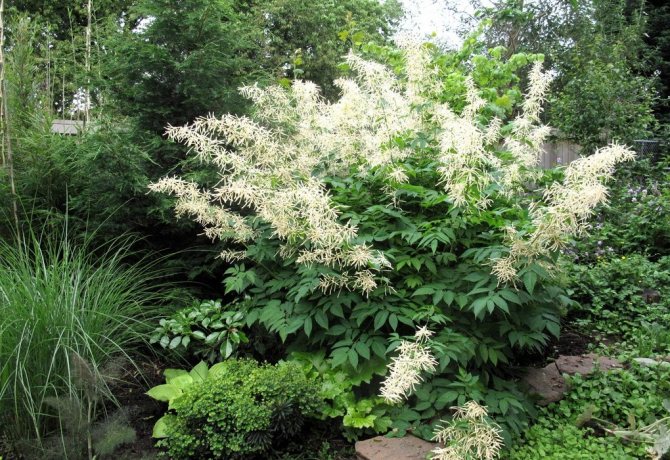

The variety has a highly decorative Kneifi variety. It is distinguished by bright green finely dissected foliage. The petioles are long, drooping. The height of the bush does not exceed 60 cm.
Aruncus asiatic with the same high growth it has coarser and darker leaves. Flowers are collected in complex snow-white panicles, each height does not exceed 35 cm. Attracts with lush and thicker spikelets of inflorescences. Flowering occurs in June, and seed ripening ends in early September. The plant is frost resistant and grows in the northern regions.
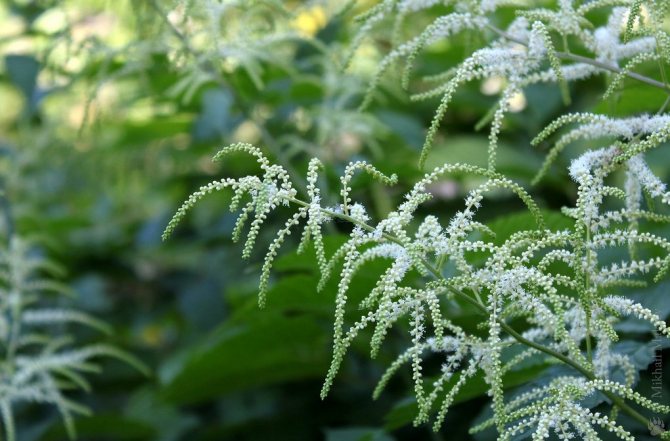

The breeders have developed the Fontana variety, which is less than 55 cm tall and has large drooping panicles of flowers. The plant loves damp, shaded areas and looks good off the coast of water bodies. Blooms in June and July.
Arunkus Kamchatka occurs in the Kuril and Aleutian Islands, Sakhalin, Kamchatka and Alaska. It grows in meadows among forbs near the sea coast or mountain slopes, climbs on rocks or stony embankments. A dioecious perennial with a height of 30-150 cm with thick woody roots. Leaves are dark green, double dissected, feathery. The leaf plates are attached in pairs to a long petiole.The panicle of the inflorescence is compact, weakly branched, and is 20 cm high. Flowering occurs in July and August, seed ripening ends at the end of September. The variety has an alpine subspecies, it is only 30 cm high.
Aruncus aethusifolius
Plants of this species are the smallest and most compact. Volzhanka kokorishelistnaya reaches a height of 25 cm. The flower is very beautiful and exquisite. The leaves are feathery, of a dark green hue and glistening bewitchingly in the sun. Inflorescences are creamy white, located slightly higher from the leaves. This aruncus blooms from June to July. Volzhankus is often used to decorate curbs, and can also be grown in pots at home. The plant is very responsive to organic fertilization.
Did you know?
In autumn, the leaves of aruncus koroshilistny acquire a beautiful reddish tint. In one place, a plant can develop for about 10 years.
Care rules
Aruncus is a shade-tolerant plant, the leaves dry quickly in the bright sun, and it slows down in growth. It is undemanding to soils, but needs regular moistening. Abundant and regular watering is required. It responds well to organic fertilizing during the growing season and flowering. After the dying off of the ground part, fertilizer is not applied.
Withered inflorescences are cut off, and in the fall the green crown is also removed, leaving no more than 5 cm of branches. It is recommended to mulch the soil with peat and rotted foliage for the winter.
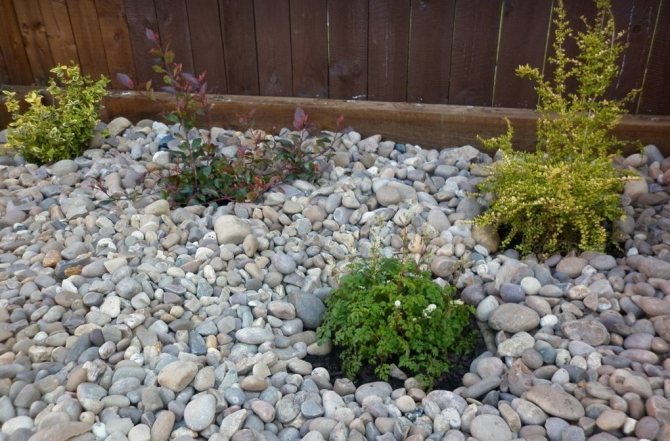

Volzhanka is unpretentious, easily tolerates severe frosts and mechanical damage. Not afraid of common diseases, but can suffer from aphids, ticks and caterpillars. A decoction of burdock or insecticides (Actellik, Intavir and others) help to cope with pests.
Aruncus aethusifolius
Belongs to the undersized species. The bushes reach a height of 30 cm, dense and very neat. Inflorescences are creamy and white. Very long, dense, in height rise 30-50 cm above the foliage. The leaves are small, dark green, oval in shape.
The most popular variety of this species is Noble Spirit.
Its bushes are only 25 cm high. Blossoming of Noble Spirit is abundant and fascinates in June with beautiful snow-white flowers. After flowering, the inflorescences retain their decorative effect, acquiring a brown color, which is formed from the ripening of the seeds.
This variety can also be grown in pots at home on a windowsill.
... For good development, the plant needs rich, loose, well-drained soil.
This unusual plant is definitely worth acquiring. Volzhanka is a large herbaceous bush with huge leaves in relation to its small flowers, forming an inflorescence in the form of a complex panicle brush.
Outwardly, it is very similar to an inflorescence, but three times larger - the height reaches 1.5-2 m, and the diameter is up to 1.5 m.
The flowers are so fragrant that there is a hum over the plant from bees and bumblebees.
In the landscape it is used as a single plant, it is perfect for semi-shady flower beds, and it is also an excellent ornamental shrub for. Purple foxglove, bells or meadowsweet can be excellent partners for Volzhanka. Planted side by side will give contrast.
For central Russia, Volzhanka is an ideal plant.
Variety "Perfection"
Like all types of Volzhanka plants, the Perfection variety is distinguished by its unpretentiousness and ease of care. At the same time, it looks like a small compact bush up to 35 cm high.
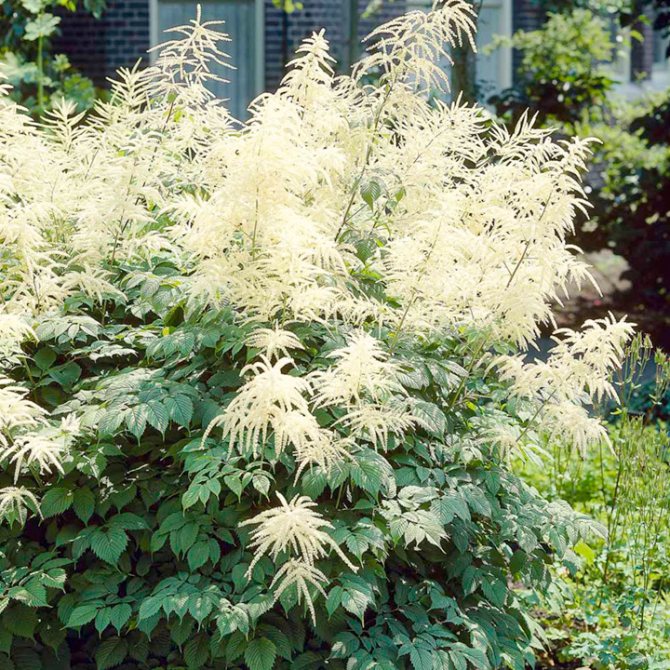

Fluffy white inflorescences in the form of beautiful light panicles, after the seeds ripen, turn into reddish boxes. In landscape design, this variety is widely used to decorate various objects. In addition, it is great for growing in pots. The only drawback of this variety is its weak frost resistance.
Place and soil
To plant Volzhanka, you need moist soil, rich in humus in a semi-shady place.Take seriously the choice of the planting site, as this plant will "live" up to 20 years.
Landing
- Prepare planting pits measuring 30x30x40 cm so that the plant has room to grow the root system.
- Mix the earth with humus, cover the seedling, compact it slightly and water it well.
- Mulch with chopped bark, wood chips or sawdust.
Volzhanka blooms in June-July.
Vegetative propagation
With vegetative propagation, flowering occurs much faster. The division of the rhizome is carried out in early spring, before the start of sap flow. To do this, part of the roots is dug up and separated from the mother plant. As the roots become stiff, a sharp knife or ax will come in handy. 1-2 buds and filamentous roots should be visible on the cut. The place of the cut is sprinkled with ash, sulfur or crushed coal and immediately added dropwise in a new place so as not to dry it out. Flowering is possible in the first year after transplanting.
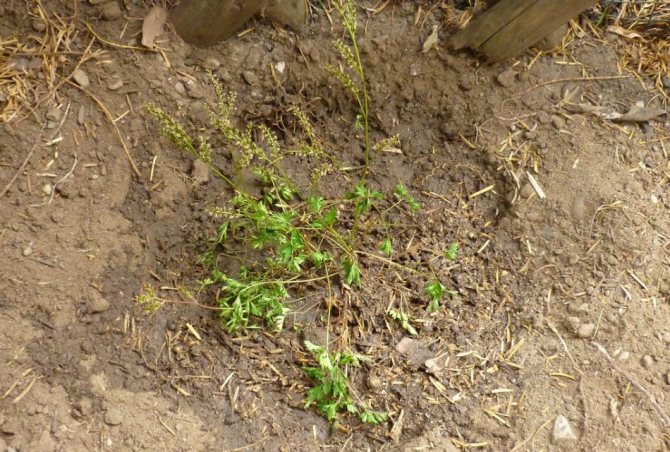

Species diversity
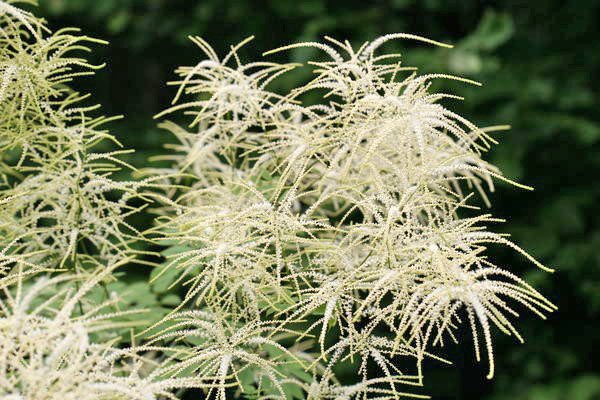

About 12 species of aruncus are known in nature, but no more than five are used in landscape design.
Asian Volzhanka
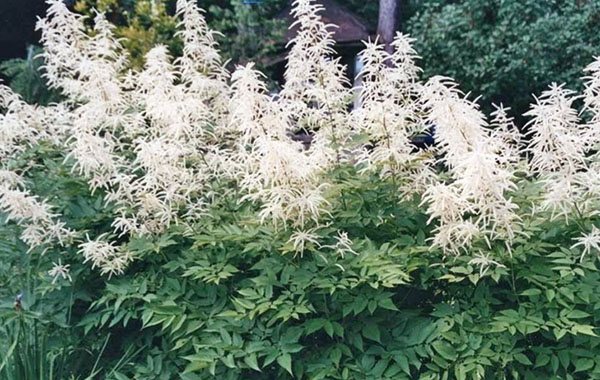

Ornamental shrub up to 2 m high. Leaves are hard, overweight. Small white flowers, collected in paniculate inflorescences, reaching a length of 40 cm. Flowering begins in early summer and lasts 30 days. Asian aruncus is highly cold-hardy and suitable for growing in northern regions. There are undersized varieties of this species up to 100 cm high.
Volzhanka ordinary
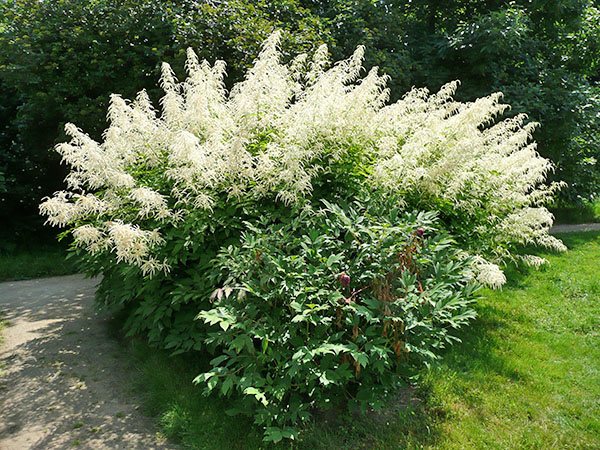

Sprawling bush, up to 2.5 m high. Compound overweight leaves. The length of the inflorescences reaches 50 cm. Male inflorescences are denser than female ones. The flowering time lasts up to 40 days.
The most common varieties used in landscape design:
- Kneffi is a culture with a height of 50 to 80 cm. The color of the inflorescence is light cream.
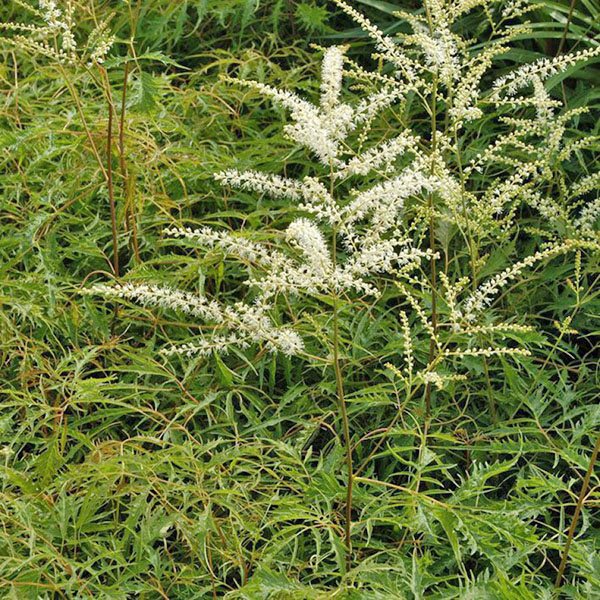

- Horatio is a low-growing plant with a stem height of up to 60 cm. The color of the stems is claret-red.
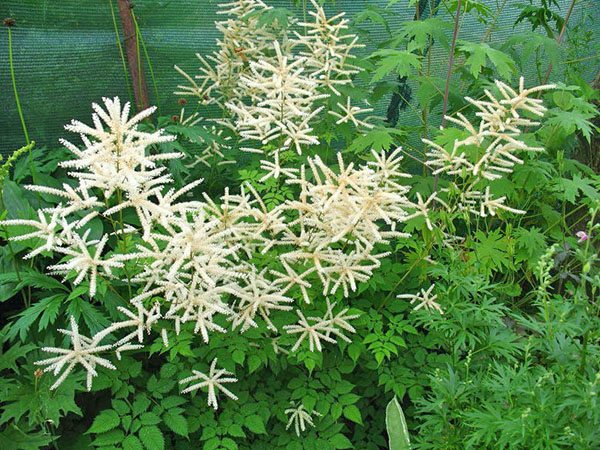

- Perfection - undersized compact bush, up to 50 cm high. The color of the inflorescences is white.
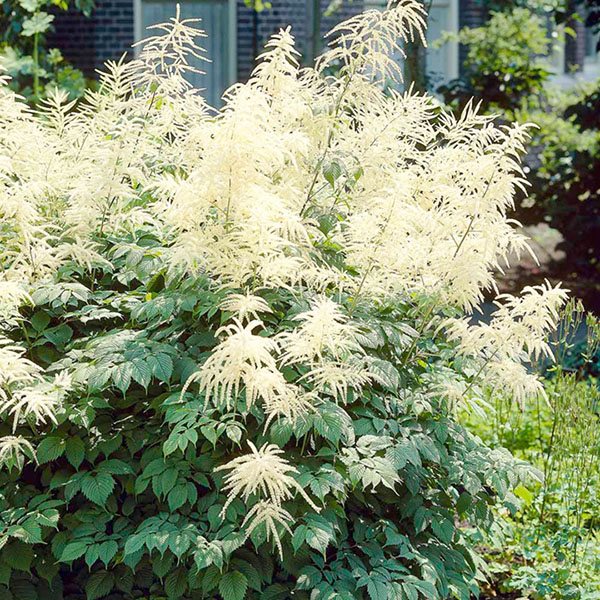

- Misty Lace is a drought tolerant variety. The color of the panicles is cream.
Kamchatka
The bush is up to 1.5 m high. The peculiarity of this species is the more delicate foliage and the relatively small size of the inflorescences (up to 20 cm).
Chinese
Chinese Volzhanka is a shrub up to 1.5 m high. Inflorescences of white and cream color up to 30 cm long. A distinctive feature of the plant is over-mature, brownish-green leaves.
Varieties of Volzhanka dwarf
Very often, low-growing varieties of Volzhanka are used in landscape design:
- Aruncus is korotyshy. The height of the shrub usually does not exceed 25 cm.
- Alpine Volzhanka (f. Alpina), the height of which varies around 30 cm.
There is a miniature variety of Asiatic Volzhanka. The average height of the shrub is 20-30 cm.
What does Aruncus combine with?
Depending on the variety, dioecious aruncus can be combined with various flowers, both in the flower bed and in the garden.


Low varieties are used most often for arranging flower beds, they can be combined with low bushes of roses or other flowers.
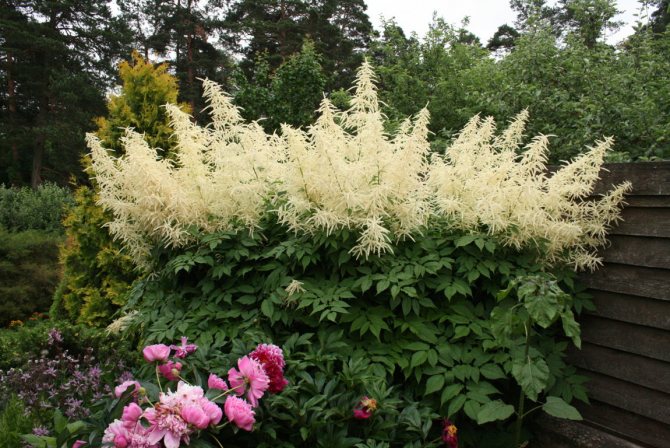

Aruncus dioicus (Aruncus vulgaris)
It is important that the combined flowers have inflorescences of different colors. Thus, it will be possible to give the flower bed brightness, saturation and contrast.
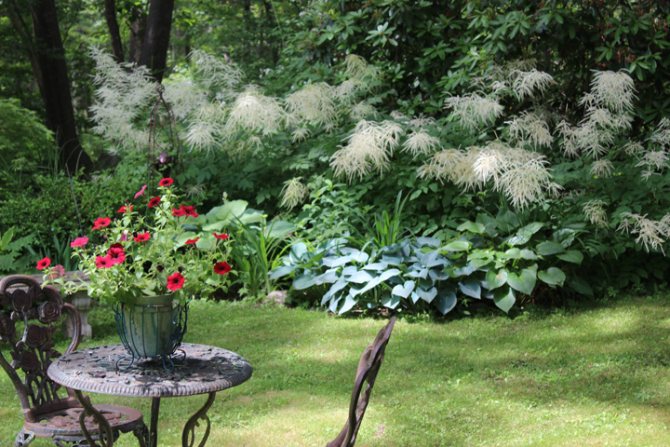

Of course, Volzhanka can also be planted separately near a fence, walls of a house or some kind of reservoir.
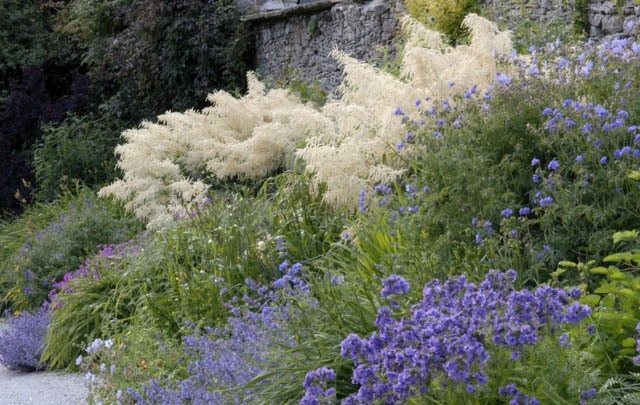

Herbal border in June with common aruncus at Sizergh Castle, Cumbria, UK.
Such a bush will only decorate your suburban area. For such purposes, as a rule, aruncus fountains are planted, reviews of which indicate that it is ideal for creating a quick and graceful decoration.
Enemies of the Volzhanka
The main enemy of the plant is bright sunlight. If the bush grows in a place unprotected from the sun, then the leaves lose their brightness, turn pale, growth stops and you can not wait for flowering.
Aruncus is practically not susceptible to diseases. There is one enemy of the foliage - the sawfly.The invasion of green caterpillars begins to eat up the leaf blades. At first, veins remain, and then holes appear. They can eat young leaves completely.
They get rid of this misfortune by digging, loosening and weeding in the summer and autumn. If the invasion cannot be stopped, then it is necessary to resort to spraying with insecticides.
Reproduction of the Volzhanka shrub by seeds
Aruncus is propagated in two ways: by seeds and by dividing adult overgrown bushes.
Seed reproduction of Volzhanka is quite successful, but difficulties arise during the very collection of seeds. On female plants, small leaflets contain dusty pink-brown seeds. To collect them, the inflorescences are carefully cut, put into a paper or plastic bag and stored in a dry place until they are completely dry. The seeds will fall out of the dry inflorescences on their own if they are properly shaken.
Seeding is carried out in September or October before the onset of frost. To do this, small boxes are filled with nutritious loose soil and seeds are buried in it. The soil is moistened, the boxes are removed in a warm, bright place. In warm regions, you can sow seeds directly into the ground before winter. Seedlings appear in early spring.
When the first pair of leaves appears in the seedlings that have appeared, they are dived into the ridges at a distance of 10-15 cm between the plants, followed by transplantation in the spring of next year at a greater distance. Flowering with seed propagation can be expected in 3 - 4 years.
You can sow seeds in early spring in boxes, or in April directly into the soil. It is recommended to plant Volzhanka seedlings in open ground and take care of them when they grow up and get stronger.
Volzhanka care tips
What is needed for good plant growth? The most important thing is to follow the care recommendations exactly, namely:
- Establish regular watering. The plant will grow only in fertile and moist soil, therefore it is necessary to establish abundant watering and avoid drought. Experts recommend laying a small drainage system on the bottom, which will protect the roots from severe waterlogging and decay.
- Introduce nutrients. Before and after flowering, a small amount of fertilizer should be applied. Do not forget to follow exactly the rate indicated on the package so as not to harm Volzhanka.
- Pruning. To make the flower look original and unique, it is recommended to cut it and destroy damaged branches. An important role is played by weeding and mulching. For this, peat or straw is often used.
Volzhanka is an original plant, thanks to which you will be able to decorate your landscape plot in the best way. If you notice slight yellowing on the leaves, do not forget to spray the shrub with special preparations or a weak solution of laundry soap. Volzhanka, planting and care, a photo of which will help everyone, even inexperienced summer residents, get a beautiful and bright flower on their territory. We hope that our tips will encourage you to pay attention to this plant and plant it in your summer cottage.
Planting Volzhanka on the site - where to start?
First of all, we note that Volzhanka can reproduce in several ways: by seeds, cuttings and division of rhizomes. Which one is better depends on the planting time and soil composition. Experts recommend planting the plant in early spring or late autumn, when the ground is warm enough. It is better to sow seeds on fertile soil, rich in vitamins and all necessary microelements. What conditions need to be created for planting a flower? Highlight the main points:
- Location. Aruncus is planted in a well-lit, slightly darkened area. You shouldn't plant the plant under a spreading tree or shrub, as the root system needs enough sunlight. The flower loves quiet places where there is no draft.
- The soil.In order for Volzhanka to grow and delight you with its flowering, you need to take care of the presence of nutritious soil. Many summer residents do this: they mix ordinary soil with compost, peat or humus. This composition is an ideal solution for growing ornamental plants.
- Fertilizers. A small amount of liquid mineral fertilizers can be added to the hole. This will help the flower to grow stronger in the early stages of life. It is best not to use organic fertilizers, especially fresh manure. An excessive dose can lead to the death of the root system or infection with various diseases. Mullein can also cause pests.
Winter, even severe frosts, are not terrible for Volzhanka, but when it comes to spring frosts, they can harm the young plant and its root system. The flower grows actively until the beginning of July, after which a period of active flowering begins. It is then that experts recommend applying fertilizers, alternating mineral and organic.
Volzhanka flower
Brief description and characteristics of Volzhanka
The stems of the aruncus plant grow up to 2 m, lush inflorescences, panicles, which are often called "champagne spray", rise above them. The plant is shade-loving. Caring for him mainly consists of watering, loosening the soil in the near-trunk circle and pruning shoots in the fall. The plant is appreciated by gardeners for its spectacular, attractive appearance and pleasant smell of its inflorescences.
Volzhanka is often confused with astilba, but these are different cultures.
In water, cut branches of Volzhanka stand no more than two weeks, so it is better to make winter bouquets of them. Volzhanka branches with panicles at the ends should be hung upside down in a well-ventilated room and wait until they are completely dry. This usually takes no more than two weeks. Once the branches are dry, they can be incorporated into a floral arrangement or simply placed in a vase without water.
In the photo: Volzhanka flowering
Types and varieties of Volzhanka
The tallest species of the genus Volzhanka dioecious grows up to 2 m in height. She has strong roots, a branched stem, beautiful dissected foliage, above which tall openwork panicles, consisting of small flowers, hover in cream or white clouds. Volzhanka dioecious bloom lasts from June to July. This species prefers partial shade, but if you plant it near a pond or lake, then Volzhanka can grow under the sun.
In the photo: Beautiful flowering Volzhanka
The leaves of the miniature volzhanka koroshilistnaya, cut into small segments, are especially attractive in autumn: at first they turn red, and then they acquire a bronze tint. In the middle of summer, the plant is covered with many inflorescences. Volzhanka kokoryshelistnaya does not need additional feeding, it prefers to grow on moist soil, near water bodies. Its lush bushes will look great between hellebore clumps, on a shady saxifrage carpet, or next to other small plants - liverworts, European hoof.
In the photo: Volzhanka in a flowerbed Of the varietal volzhanka, the most popular are:
- Noble Spirit is a round shrub up to a quarter of a meter high, which blooms throughout June. After flowering, the leaves gradually acquire a peculiar reddish tint. Noble Spirit is often grown as a pot crop, as well as on curbs and mixborders;
- Asian - this variety can reach a height of 2 m. The plant has powerful roots, rough feathery leaves and lush white panicles up to 35 cm long from small flowers. This winter-hardy variety blooms throughout June, and the seeds ripen in early autumn;
- American - This perennial blooms for the first 3 weeks of summer. Its shoots form a dense thicket of a meter in height, but sometimes they can be higher. This Volzhanka grows very quickly: in one year, the branchy rhizome adds in length from 5 to 7 cm.
Volzhanka care
Volzhanki are durable: they can grow without transplant for 20 years.If you planted a plant in the sun, its white flowers may turn yellow under bright rays, so it is better to place the Volzhanka in a shady place, next to a fruit or coniferous tree.
The soil of the Volzhanka needs fertile and moist: the plant can tolerate even a prolonged excess of moisture in the roots.
If Volzhanka is planted correctly, then minimal care is required: the main thing is to cut off the inflorescences after they bloom, and in the fall, shorten the shoots to 5 cm.If Volzhanka suffers from thirst, its leaves begin to curl, and then you need to pour at least three warm buckets under the bush water. After watering, remove the weeds that have appeared around the bush and slightly loosen the soil.
When grown in poor soil, it is still advisable to feed the plant: during planting, you need to add 30 g of Nitrophoska or 2 kg of humus to the hole and mix them thoroughly with the ground so that the fertilizer does not come into contact with the roots of the plant; in the spring, nitrogen fertilizer should be applied to the root area, and 2 weeks after that, water the soil around the plant with infusion of grass (weeds), filtering and diluting it with water. After flowering, the Volzhanka will need phosphorus-potassium fertilizers, and after applying them, you need to water the bush abundantly and mulch the surface with a layer of sawdust, coniferous litter or peat 5 cm thick.
Photo: Mulch
Volzhanka is extremely rarely occupied by pests, almost does not get sick and tolerates winter frosts well.
Volzhanka reproduction
Volzhanka can be propagated in different ways: by cuttings, seeds and dividing the bush.
You can divide the Volzhanka bush only when it reaches the age of five. The volzhanka is dug up and cut into pieces with a sharpened shovel or ax. A heavily overgrown bush, which is difficult to pull out of the soil, can be divided in a planting hole, and then pulled out of it in parts. For planting the delenki, holes are dug with a depth and width of about 40 cm. Depending on the type and variety of Volzhanka, delenki are planted at a distance of 80-120 cm from each other. A bucket of compost is poured into the pit, mixing it with the removed soil. After that, a seedling is placed in the pit, a bucket of water is poured out and the planting pit is filled with soil. With constant watering, the seedling quickly takes root and begins to bloom the next year.
For reproduction of Volzhanka, the green tops of the shoots are cut by cuttings. They are stuck in loose soil, watered and shaded from the sun's rays.
Volzhanka is rarely propagated by seeds: they are harvested in early autumn and sown in a school. The next year, the seedlings dive with a step of 12-15 cm, and a year later they are planted in a permanent place. Volzhanka from seeds bloom only in the third spring.
Designers appreciate aruncus for its shade tolerance, ability to grow in dampness and high decorative qualities that the plant does not lose throughout the season: in summer it attracts attention with fresh green foliage and lace inflorescences, and in autumn - carved reddish or bronze foliage.
In the photo: Volzhanka in landscape design
In landscape design, Volzhanka is used both as a specimen and as a background plant in a group planting. In partial shade, the neighbors of the Volzhanka can be aconite, bells, geraniums, meadowsweet and purple foxglove, and in shady places it can grow next to ferns, miniks, hosts and shititniks.
Botanical description of Volzhanka
Volzhanka is common in the temperate zones of the Northern Hemisphere.
The generic scientific name is given for the appearance of the inflorescences. Pre-Linnaean botanists called it "barba caprae" - "goat's beard", Karl Linnaeus renamed the plant "aruncus", from the Greek "arynkos" with the same meaning.
According to the botanical description, Volzhanka is a perennial herb that is prized for its lush openwork foliage and beautiful large inflorescences. The height of the bush depends on the variety and can vary from 20 to 200 cm. The width of an adult shrub can reach from 50 to 120 cm. The stems are strong, straight.The root system of the plant lies close to the soil surface and has strong branching. With age, the roots lignify and grow to the sides.
Leaves are compound, double or triple pinnately dissected, serrated along the edge, dense, even hard, dark green. Attached to long petioles. Stipules are absent.
Peduncles are long, up to 60 cm. Flowers are dioecious, small, white or cream, collected in a complex racemose panicle. Female flowers are more lush and dense. Male ones are more sparse and have an openwork edge. Flowers are formed at the top of the plant. Aruncus blooms in late June - early July. The flowers have a strong scent that attracts insects.
The fruit is a leaflet with a leathery pericarp that contains small, thin seeds.
A photo of the plant is attached to the description of the Volzhanka, so that flower growers can better represent this culture.
Seed propagation
This type of breeding will be the most painstaking. At the tops of female plants, medium-sized seeds ripen with a pink-brown tint. In order to separate the seeds, it is necessary to place the cut panicles in a bag (inflorescence downwards).
Sowing is carried out in late autumn in a box or in the ground (open) at a distance of fifteen centimeters from each other. Seedlings appear in spring. At the end of the season, they are transplanted to the site. The pits should be located at a distance of seventy centimeters to one meter. The shrub will begin to grow next spring, but only after three to four years will it bloom.
Of course, nature was conceived in such a way that a perennial can reproduce without human intervention. Every year his rhizome grows and gives root shoots. And the seeds that survived, falling into the ground, give new shoots, that is, self-seeding is obtained.
Preparing for landing
When preparing the soil for planting a plant, it should be borne in mind that Volzhanka is perennial and can grow up to 20 years in one area. If planting is carried out in cultivated soil, top dressing is applied only to the planting pit. For this, 2-3 kg of humus or a tablespoon of nitrophoska is enough.
Loose moist fertile soils are preferred for shrubs.
Advice! Placing shrubs outdoors in direct sunlight can cause burns and discoloration of foliage.
Varieties, types and features of the plant
Very high grade - Volzhanka dioecious (A. dioicus), which is sometimes called forest (A. sylvester) or common (A. vulgaris). It is two meters high, but it expands slowly, only over time creating large bushes.
The species name “dioecious” Volzhanka acquired because both female and male plants are found. They can be distinguished from each other by the color of the flowers and the density of the inflorescences. Thus, in female plants, flowers are pure white, loose inflorescences, flowers on male plants are creamy white and are clustered in more frequent inflorescences. Volzhanka dioecious blooms in the middle of June, and blooms for a long time - up to three weeks, creating large, 50-60 centimeters in length, inflorescences.
Today in the implementation you can meet the variety 'Kneiffii' - a plant only 60 centimeters high with surprisingly exquisite deeply dissected feathery leaves.
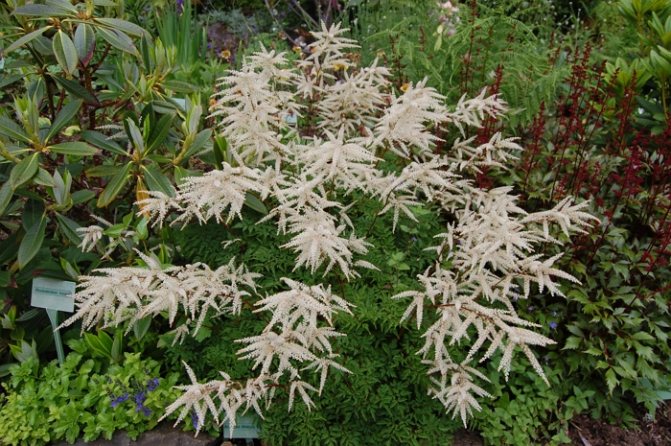

The most compact dimensions are Asian Volzhanka (A. asiaticus). Since this species is found not only in Siberia and the Far East, but also in North America, it bears a middle name - American Volzhanka (A. americanus). Because of the tall rhizomes, it makes a dense thicket 80-100 centimeters high. The leaves of this species are less dissected than those of the Volzhanka dioecious. It dissolves in late May - mid June.
The smallest of Volzhanka and quite popular now - Volzhanka coral (A. aethusifolius). It is difficult to call her an extremely graceful plant: her inflorescences are rather short and not so luxurious, and the flowering period is only two weeks, but there is also an indisputable advantage: a compressed compact bush with a height of only 25-30 centimeters.
This is one of the latest flowering Volzhanka, the period of its flowering is July. Sometimes inexperienced flower growers confuse Kokoryshleistnaya Volzhanka with astilba.
Volzhanka has been grown in the gardens since the first half of the 17th century. Has become the focus of breeders' attention especially recently.Modern varieties are denser, have a different color of inflorescences and configuration of leaves than those of species plantings. Among the elite: ‘Johannisfest’ (60 cm) with openwork foliage and white flowers; ‘Waldemar Meyer’ (110 cm) with white flowers in narrow inflorescences. ‘Misty Lace’ (75 cm) with bright emerald “fern” leaves, scarlet shoots and stalks, white flowers is not only beautiful - it can easily withstand heat and dry periods.
Decorative properties
The plant is widely used in landscape design. It can be used to mask unsightly areas of the garden that need to be hidden from prying eyes.
Astilba creates a good combination with Volzhanka in one garden. Other plants look good along with aruncus:
- Hosts;
- Japanese spirea of dwarf varieties;
- Ferns;
- Coniferous plants;
- Low-growing forms of juniper.
Thus, everyone can start a Volzhanka on their site - it does not need special care and can grow on any soil. It makes a good composition with other plants, but looks no less beautiful in the form of a single shrub.
The healing properties of the plant
Professionals have studied in detail the chemical composition of Volzhanka vulgaris. It contained hydrocyanic acid, tannins, polysaccharides, organic acids, amino acids, proteins, a huge number of trace elements and vitamins. Aruncus foliage contains flavonoids, essential oil, vitamin C and hydroxycinnamic acids. Volzhanka roots contain aromatic and nitrogen-containing compounds.
It is by this rich chemical composition that the medicinal characteristics of Volzhanka are determined. Aruncus has the following medicinal properties:
- anti-febrile;
- tonic;
- astringent;
- pain reliever;
- antipyretic;
- choleretic;
- antioxidant.
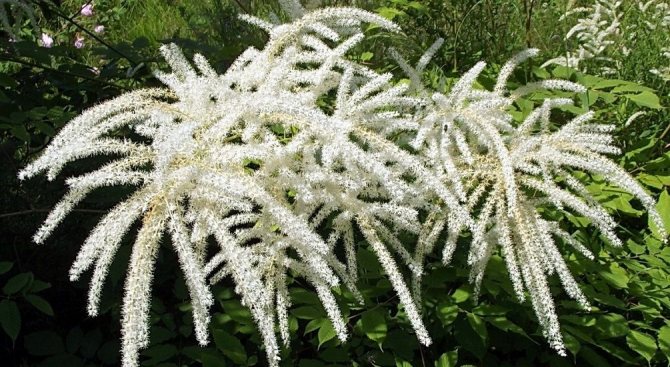

Volzhanka vulgaris is widely used in folk medicine. The flowers, roots and foliage of the shrub are used to make all kinds of remedies that help in the treatment of certain diseases. For example, for diarrhea, renal pathologies, rheumatism, colds and gonorrhea, an infusion of Volzhanka rhizomes is used. Aruncus-based drugs are additionally used to stop profuse bleeding after childbirth, as an antipyretic for severe fevers. Infusions are added to trays to combat leg swelling.
The crushed roots of Volzhanka vulgaris are advised to be used to relieve painful sensations in the kidneys. Means for external use are also made from this medicinal plant, which are used to heal ulcers on the skin. Fresh crushed roots are applied to the injured parts of the skin. With a large cough, it is advised to keep the dried roots of dioecious aruncus in the oral cavity.
Types of Aruncus and its application in landscape solutions
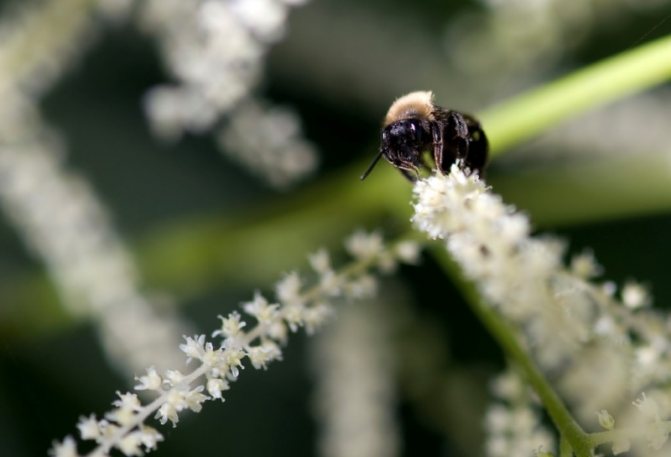

Thanks to its bright green foliage and snow-white flowers, Aruncus can complement any stylistic solution of the garden landscape. This fluffy shrub will brilliantly fulfill the role of the center of the flower bed, will look great on the shore of an artificial garden pond, or delight with its appearance sitting under a window or balcony. The most popular among our gardeners are such species as the Asian Aruncus, the dioecious Volzhanka, as well as the decorative miniature hybrid with the telling name "Perfection".
(
1 votes, rating: 5,00 out of 5)
← Previous post
Next post →
Features of breeding Volzhanka
Aruncus are easy to care for and do not take a lot of time to breed. Nevertheless, do not forget about this flower, because the state of its appearance and the splendor of flowering largely depend on its care.
Location. When growing Volzhanka, gardeners should remember that light shading is most suitable for her with a sufficient supply of moisture in the soil. It develops quite well in open places.In the sun, the plants burn out, their leaves acquire a yellowish tint. It is best to plant a flower under the spreading crowns of trees, not far from water bodies, in places protected from gusts of wind and drafts.
The soil. Planting a Volzhanka flower can be carried out on any soil, since it is unpretentious, it can grow on both heavy and light, but always moist, fertile, deeply processed soils. The good growth of Volzhanka is facilitated by sprinkling the soil around the plant with peat or wood chips. This mulch holds water in the soil and the plants receive nutrients.
Top dressing. Organic fertilizers react very well. During planting, fertilizer is introduced into the pit in the form of compost or humus. Further, in the process of growing Volzhanka plants, fertilizing is applied 1 - 2 times per season - in spring and autumn. For this, complex mineral fertilizers and organic matter are suitable. Do not overuse fertilizers with a high nitrogen content. This will stimulate the appearance of lush foliage, but negatively affect flowering.
Watering. This flower responds well to abundant watering, so it should be watered regularly and abundantly (3-4 buckets per adult bush). Aruncus quickly grows foliage and quickly loses moisture. Insufficient watering negatively affects the decorativeness of the plant.
Pruning. Carrying out care when growing Volzhanka, immediately after flowering, the inflorescences are cut off, which helps to preserve the neat appearance of the plant. The bushes are pruned in the fall, leaving hemp 3-5 cm high.
Winter hardiness. Since aruncus can withstand severe frosts without being damaged, they do not need to be covered for the winter. The only exceptions are young specimens planted in the fall and did not have time to get stronger. For them, a shelter is made, which is used as peat, spruce branches, humus or dense material.
Rejuvenation. Despite the fact that the perennial plant Volzhanka can successfully grow in one place for 10 years or longer, it still needs to be periodically rejuvenated. This is done by dividing the rhizomes and planting in a new place. If rejuvenation is not carried out, after a while the inflorescences of the aruncus will become small, and the plant itself will look like a large green bush.
Species and varietal diversity
All varieties of Volzhanka are decorative and unpretentious. Their differences lie in the height and appearance of the inflorescences. The most popular and frequently used representatives of the culture:
- Volzhanka Kokoryshelistnaya
- Volzhanka Ordinary
- Volzhanka Kamchatskaya
- Volzhanka American
- Volzhanka vulgaris. Its decorative leaves are large, and the plant itself reaches 200 cm in height. Flowering lasts from early to mid-summer (40 days). The plant has a sexual division. Feminine flowers are white, with a loose structure. The masculine gender has a denser structure and a creamy shade.
- Kamchatka. A plant with small inflorescences (up to 15 cm) reaches a height of up to 150 cm.
- American. The growth of this miniature variety does not exceed 100 cm. Modest flowering lasts from late spring to early summer (20 days).
- kokorylistnaya. This dwarf representative is only 25 cm high. The inflorescences are a dense arrangement of tiny flowers, and look very lush. In combination with bright leaves, the plant adorns the landscape design throughout the warm season.
Volzhanka dioicus (dioecious, common): plant characteristics
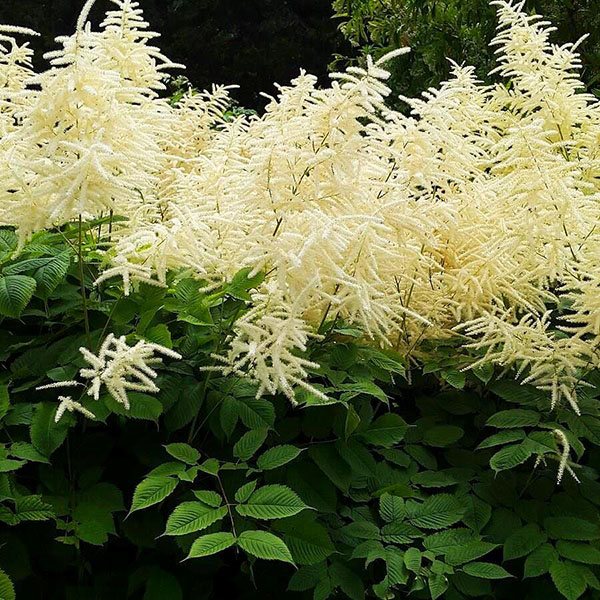

This variety of Volzhanka comes from the Caucasus. Despite the external resemblance to astilba, the plant differs in size and color of the buds. They are completely different, it all depends on the gender of the flower. In Volzhanka dioecious, female flowers are often painted only white, but male flowers acquire a beige tint. In terms of size, the buds are quite large, in addition, they are much more powerful than the Astilbe.
Volzhanka has been living on one site for over 9 years.In autumn, its leaves become deep red and do not fall off for a long time.
Dioecious Volzhanka grows up to 1.9 m tall. The plant is distinguished by long, even stems. With proper care, the bush grows in diameter up to 1.1 m. Leaves appear from thick petioles, which outwardly are somewhat similar to fern plates.
There are the following types of Volzhanka common:
- Forest Volzhanka Dzineya fow. The plant throws out white-pink flowers, reaches 1.9 m in height.
- Volzhanka Kneffi. The flower loves water, grows no more than a meter, is distinguished by carved branched leaves.
In the garden of flower growers, you can often see the volzhanka dioica and its interesting varieties.Volzhanka kokoryshelistnaya
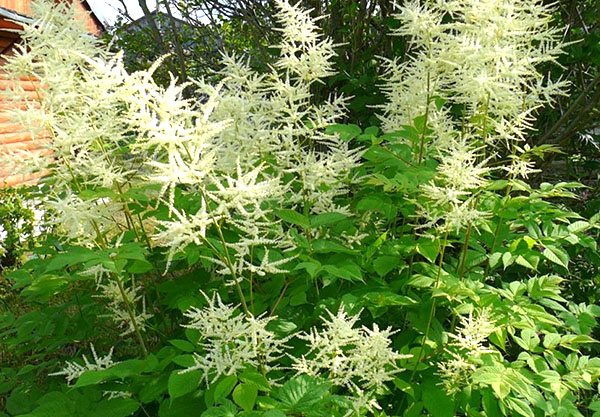

This is a small bush, the height of which reaches only 27 cm. The plant is considered undersized, but at the same time original and sophisticated. Beautiful dark leaves charmingly shimmer under the sun's rays. Creamy white flowers form on the plant. They are located above the leaves. Flowering occurs in June-July. This type is most often used to decorate flower beds and borders.To make the bush beautiful and healthy, feed it with organic fertilizers. It is also recommended to use universal granular products.
Aruncus perfection
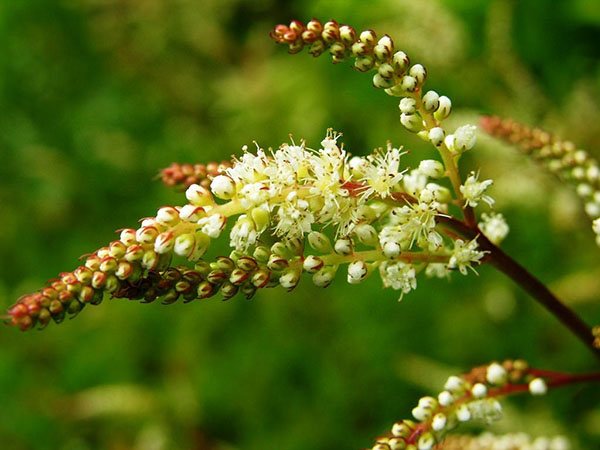

This type of Volzhanka also does not differ in its large size. The height of the bush grows about the same as that of the cocoa lupus. Aruncus perfection has a compact form. Inflorescences in this species have the shape of a panicle. The buds are white and dense. The seeds form in capsules, which turn red by the time they are fully ripe. This variety is often used in landscape design compositions.Arunkus perfection looks beautiful in flower beds, near ponds.
If Volzhanka grows in an area with a warm climate, it is simply covered with a film for the winter. This will be enough for the flower to tolerate low temperatures well.
Many gardeners speak warmly about this variety of Volzhanka. This is due to its beautiful appearance and unpretentiousness.
American Volzhanka
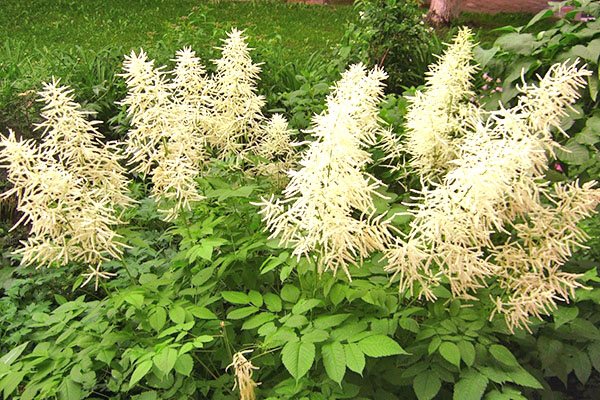

The homeland of this variety is North America. The plant is quite tall - almost a meter. Flowering occurs in early summer. The rhizome of the bush is quite long, and every year about 7 cm is added to it. This variety is considered not as spreading as the dioecious volzhanka. The leaves are light green, carved. Inflorescences are collected in light spikelets.The American Volzhanka has much fewer buds than the common one.
The plant has earned its popularity due to its neat appearance and small size (it does not take up much space on the site). Due to this, this variety is the most popular when creating landscape compositions.
Asian Volzhanka
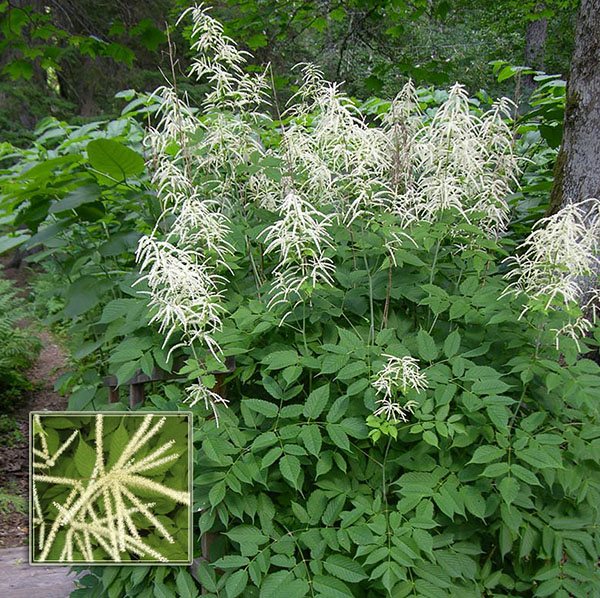

This is a tall plant that occurs naturally in Siberia. One bush reaches a height of two to three meters. The leaves are rich green. All of them are feathery and small in size.Unlike others, this species has small roots. Flowers are collected in compact inflorescences. With proper care, they bloom in June. This variety is not as susceptible to frost as the dioecious Volzhanka. After all, the natural habitat of the bush is not only Siberia, but also the eastern regions of China.
The most favorable conditions for Asiatic Volzhanka are considered to be a partial shade area and a fertile moist soil. In decorative arts, the Asian variety is used to decorate walls and other vertical surfaces.
In addition to the above species, there are numerous artificially bred varieties. Distinctive features of hybrids are various shades of buds, as well as a small compact bush, which is grown both in winter gardens and indoors.
Volzhanka, or Aruncus, description, varieties, photos, growing conditions, care, application
If you saw a luxurious spreading bush with white arrows-panicles on the banks of the reservoir - this is Volzhanka.
Description of Volzhanka
Aruncus is an unpretentious plant, growing with equal success is possible both in open areas and in shaded areas.
Perennial Volzhanka is distinguished by its resistance to drought, waterlogging and waterlogging of the soil.
The flower-bearing stems of the Volzhanka can reach a size of 1.5-2 m in height. Inflorescences are large panicles, 25 cm wide, up to 50 cm long.
Flowers are mostly small, pastel colors, with a lot of stamens. They are distinguished by a delicate and delicate scent. When grown outdoors, the flowers may turn yellowish.
Due to the large size of the plant, it is often used in landscaping for the formation of maintenance-free thickets. Volzhanka can also be used for ceremonial and backstage landings.
The plant is a good honey plant, attracting various pollinators to the site.
Planting and caring for Volzhanka is quite simple, growing and reproducing shrubs in the open field requires a little effort, varieties bred by breeders allow you to combine Volzhanka with various plants in landscape design.
Volzhanka name: for the appearance of inflorescences. Dolinneevsky botanists called it ‘barba caprae’ - a goat's beard, renamed by Karl Linnaeus to ‘aruncus’, from the Greek ‘arynkos’ - a similar meaning.
Covers about 12 species of herbaceous perennial plants, common in the temperate regions of the Northern Hemisphere. Large plants with beautiful double or triple feathery compound leaves. The flowers are small, white or yellowish, collected in large spreading paniculate inflorescences.
Volzhanka varieties
Asian aruncus - A. asiaticus A. Pojark.
In nature, it is distributed in the forest zone of Eastern Siberia and the Far East, Northeastern China. Short rhizome perennial plant up to 200 cm tall. Leaves are compound, doubly pinnate, coarser than those of common aruncus.
The flowers are small, white, in complex, dense, paniculate inflorescences up to 35 cm long. Blooms in June for about a month. The seeds ripen in September. It differs from the widespread aruncus dioecious in thicker inflorescences and coarser, less dissected leaves. More winter-hardy and goes further north.
Aruncus American -A. Americanus
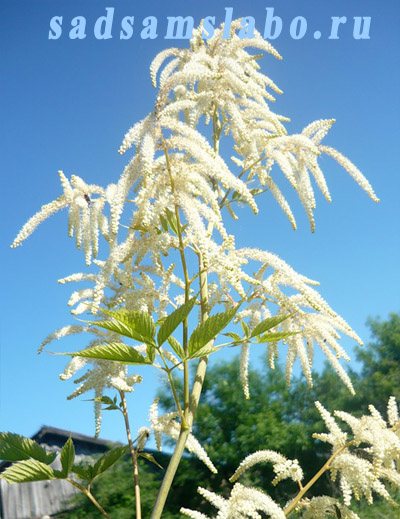

From the forests of the Far East and North America
Long-rhizome perennial, usually blooms from late May to mid-June. Shoots form a dense thicket with a height of 80 - 110 cm.The plant grows rather quickly, the annual growth of the branching rhizome is 3 - 7 cm.
Aruncus dioecious, or ordinary - A. dioicus (Walt.) Fern. = A. vulgaris
Homeland - the western regions of the European part of Russia, the Caucasus, Central Europe. Quite often found in deciduous and mixed forests. Perennial plant up to 200 cm tall with erect, leafy stems forming sprawling bushes up to 120 cm in diameter.
Leaves are compound, openwork, double or triple feathery, on long, strong petioles. Inflorescences are paniculate, spreading, up to 50 cm long. Inflorescences of male (staminate) flowers are denser, female ones are more rare, openwork. The flowers are small, up to 0.3 cm in diameter, white or slightly greenish. Blooms in June-July for 30-35 days.
The fruits are leaflets. The seeds are small. The seeds ripen by mid-September. In culture since 1623. It has several garden forms, of which the most common form is Kneifi (f. Kneifii) - see the photo on the right, up to 60 cm high with leaves cut into small lobes, somewhat drooping.
All about growing a host. The best recommendations. We read ...
When grown from seeds sown before winter, it blooms in the third year. Blooming Volzhanka exudes a pleasant tart aroma that attracts various insects from hoverflies to graceful butterflies.
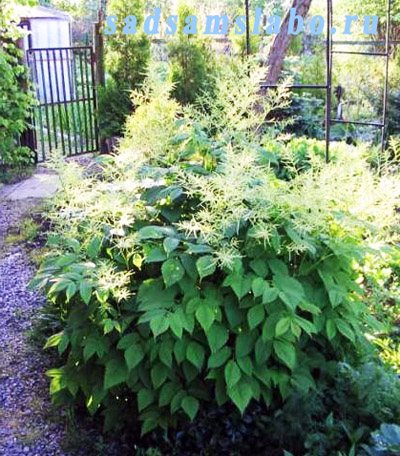

Aruncus Kamchatka -A. Kamtschaticus (Maxim.) Rydb.
In nature, it is widespread in Kamchatka. Plant up to 150 cm tall. Leaves are compound, double pinnate. The flowers are white, small in compact, weakly branched paniculate inflorescences up to 15 cm long. Blooms from June, seeds ripen in September. Has an alpine shape (f. Alpina) up to 30 cm tall.
Aruncus etusifolius -A. Aethusifolius
Unlike the well-known high aruncuson, reaching 1-1.5 m, this species is low and compact. offers the ‘Noble Spirit’ variety. Its rounded bush is only 25 cm high. Many snow-white inflorescences adorn plants from late May to July. Even after flowering, they retain their decorative effect, acquiring a red color when the seeds ripen.
Recommended for curbs, mixborders. Easy to grow in pots. Sow in rich, loose, well-drained soil. Within 1 week, they are kept at 10 degrees, then the germination temperature is raised to 20-30 degrees. Seedlings appear in 35 days. They are grown at 15-18 °. Plants bloom in 50-54 weeks.
All about roses. The best recommendations. We read ...
Conditions for growing Volzhanka
Location: Aruncus achieve the greatest effect with light shading and a sufficient supply of moisture in the soil. They develop well in open places. In the sun, the plants burn out, their leaves acquire a yellowish tint.
The soil: undemanding, they can be both heavy and light, but always moist, deeply processed, with a sufficient content of organic matter.
Volzhanka care
very responsive to organic fertilization. The inflorescences are cut off immediately after flowering, and the plants themselves - in the fall, leaving hemp 3-5 cm high.
In one place they can grow up to 6 years or more. Additional moisture is required during prolonged dry weather. Water the aruncus abundantly. An adult plant takes 3-4 buckets of water.
Such a large perennial needs regular feeding. In the spring, nitrogen fertilizer is applied, later 2-3 times with a break of 10-15 days fermented infusion of cut grass and weeds, diluted with water 10 times.
Immediately after flowering, simultaneously with watering, the bush is fed with phosphorus-potassium fertilizer, after which the soil around it is mulched with semi-rotted coniferous litter, sawdust or peat with a layer of 5 cm.
Volzhanka reproduction
By dividing large bushes, and this method has almost supplanted the seed method of reproduction. The bushes are divided in autumn (September) or early spring (early April). An adult 4-5-year-old plant is dug up and divided with a knife into parts so that there are at least two buds on each division.
Old bushes sometimes have to be chopped up with an ax. It is better to plant delenki right away. When planting, they need planting holes, well filled with humus, measuring 30 x 30 x 40 cm.The distance between the plants should be at least 50 cm.
After planting, they need abundant watering. The planted divisions first need to be shaded from direct sunlight. Volzhanki bloom in the year of planting, and reach full decorativeness the next summer.
The seeds are very small, the crops are sown in boxes that need a shade. Seedlings dive into ridges at a distance of 10-15 cm between plants, followed by transplantation in the spring of next year at a greater distance. After two years, the seedlings are planted in a permanent place. They bloom in the third year.
The use of Volzhanka in garden design
Volzhanki is recommended for single and group plantings among trees and shrubs against the background of a lawn or in mixed plantings in combination with other perennials, background plantings. Volzhanka dioecious is often used to decorate the shore of a reservoir.
Cut inflorescences do not last long in water (2-3 days), but they are wonderful in dry bouquets. For these purposes, they are harvested at the time of full disclosure of flowers. You can dry the panicles both upward and gracefully bent.
In the first case, the cut inflorescences are hung upside down in a dry, ventilated room; in the second, they are simply placed in a vase without water. After half a month, they completely dry out and, when arranged, successfully complement any winter bouquet, giving it romance and lightness.
Partners: in the garden, faded panicles are cut from the bush, and the lush openwork green of the leaves continues to delight the eye. Astilbe looks great against its background.
It blooms later, but it still makes good company to the Volzhanka. If white-flowered varieties are planted nearby, then it seems that the flowering of the aruncus continues in a tier below.
Volzhanka diseases and pests
Like other rosaceae, aphids and ticks willingly attack Volzhanka (aruncus). Volzhanka is resistant to climatic factors of the middle zone: it does not suffer from winter cold and frost. In case of mechanical damage, it can recover from dormant kidneys. In the wild, it is found in the Caucasus.
Pay attention to this:
| Garden creation | All about garden plants | Building a house |
| All the flowers are here | Lawn creation | We build a bath |
| Pond device | How can it be without a rock garden ... | All about roses |
Wintering is not terrible
Inflorescences are usually pruned in the fall. You can see the changes if you leave them: the color of the baked milk will change to a pale brown. Such an evolution of the state will perfectly fit into the currently fashionable concept of a wild garden.
In winter, the leaves will dry out, the stems will die off. Therefore, pruning is part of caring for the plant - three centimeters long stumps remain.
Overgrown rhizomes even tolerate a frosty, little snowy winter. Perennials are not afraid of the cold, but if a harsh winter is expected, then the cut bush should be protected. Fallen leaves, humus or spruce branches are perfect for this.
Choosing a place and growing conditions
Volzhanka is not planted in the sun. The delicate foliage quickly burns out and the plant looks depressed. The best areas for her are the banks of reservoirs, shady corners in parks, under trees, near buildings. Additional protection is required from strong winds and drafts.
Aruncus does not put forward special requirements for the soil. Loves moist and fertile lands with good drainage. When planting, they bring in a bucket of humus per 1 sq. square meter. At the bottom of the planting holes, especially if the soil is clayey, rubble must be poured for drainage.
Not only beds and flower beds
Harmony and tranquility, connection with wildlife - these are the goals that the garden or its part, ennobled by landscape design, serves.
Volzhanka dioica can be used in various variations:
- a single bush creating a white spectacular spot;
- in shade or partial shade with other perennials with contrasting colors;
- next to shrubs and trees: filling in the voids between them, it creates a harmonious transition of the palette and levels;
- in compositions with stones, household items, garden decorations, wooden elements;
- for decorating the shores of a natural or artificial reservoir;
- after curly pruning, as an unusual garden decoration.
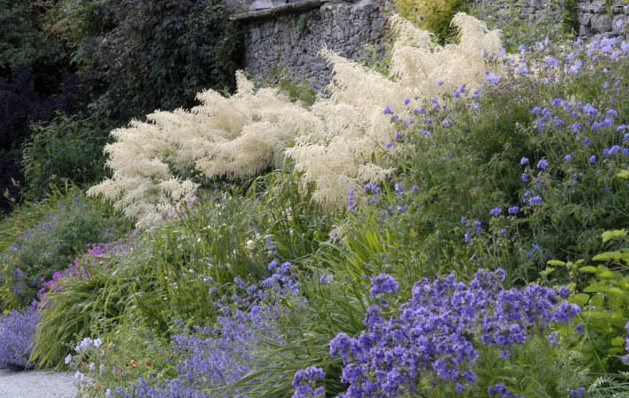

The carved leaves of Volzhanka dioecious are beautiful by themselves, so even a non-flowering plant will decorate the garden. Airy inflorescences can be used as an addition to the bouquet, they can easily replace the usual gypsophila and asparagus. However, the plant will wither within three days. But the dried flowers will turn out to be durable and effective. During flowering, white branches of inflorescences (brown in late autumn) must be cut off and dried without water in a dry room. You can use a vase without water or hang it. Decorative dry bouquet, painting made from natural materials, panels - inflorescences can be used in different ways.
A noble process is caring for Volzhan dioecious, since it responds immediately to care (fertilization, watering, transplanting). For many years this perennial will delight with simple care.Therefore, if there is an untidy piece of land or an uncomfortable looking fence in the garden, then Volzhanka dioecious will be an ideal way to solve these problems.
Dividing the bush
The division takes place in early April, when the snow melts, or in September. An adult plant (four or five years old) is dug up, then divided with a knife. The older the plant is, the more problematic it will be to divide. At least two renewal buds should remain on each part.
A hacksaw or ax will have to be used for a ten-year-old plant with a lignified rhizome. In order to dig up such a bush, you can use a pitchfork. If this is impossible, then you need to dig in from the side and separate the part. Fresh cuts after dividing must be lubricated with a special agent or powdered with wood ash, crushed coal or sulfur.

